Hiking Around Portland: A Complete Guide for First Timers
Hey there! We’re Matt and Alysha, two Portland residents who love hiking, and you’ll find us spending our spring, summer, and fall weekends (and occasionally winter weekends too!) out on the trails.
A big part of the reason that we’ve fallen head over heels in love with Portland is the fact that there is so much incredible natural beauty within about 90 minutes of our front door.
Towering snow capped peaks? Mount Hood has us covered.
Rugged rocky coastline? The Oregon Coast is exactly 90 minutes from our front door!
And we haven’t even gotten to the spectacular waterfalls found in Silver Falls State Park and the Columbia River Gorge yet.
The point is, no matter what kind of hike you’re in the mood for, you’ll find it near Portland.
Between living here and our numerous trips before we decided to make this home, we’ve done A LOT of hikes.
Which means that we’ve personally done every hike on this list AT LEAST once. So you can think of this as an ever-evolving list that we’ll add to over time as we discover more and more trails.
Each of these hikes is within 90 minutes of the city, and makes for an excellent day trip to get out of the city and experience Oregon’s diverse natural beauty for yourself.
In this guide, we’ll go through the best hikes near Portland, according to us, two Portland locals.
There are options for everyone within 90 minutes of the city – from grizzled trail veterans looking for a rugged climb, to families who want to take in some amazing views with minimal effort – and we’ve done our best to cover them all (both in terms of hiking them, and also writing about them).
Sound good to you? Let’s get into it.
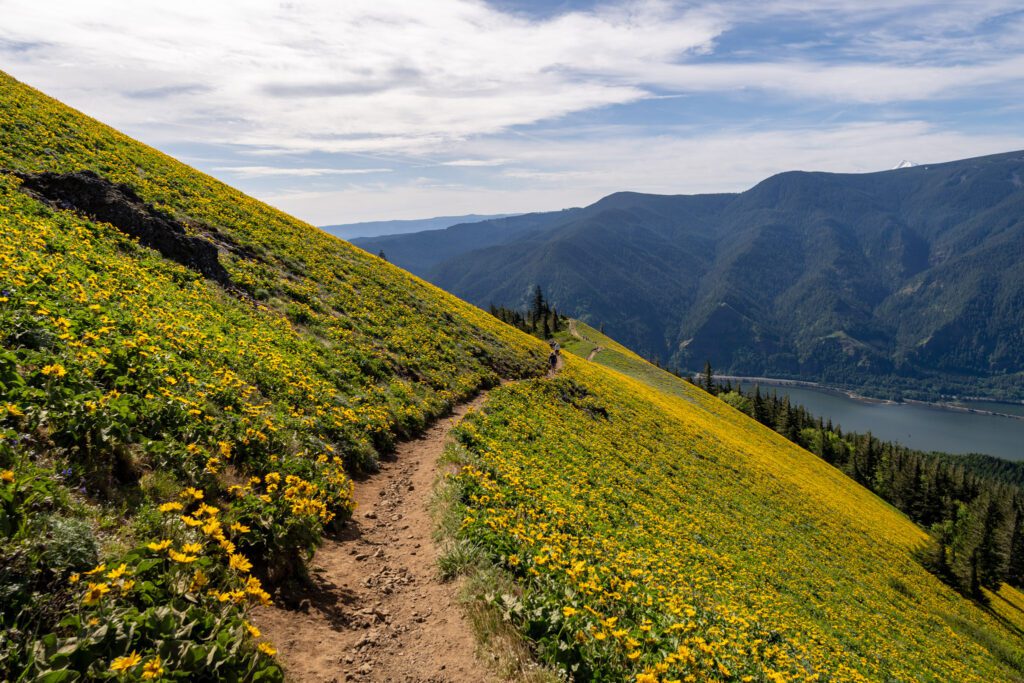
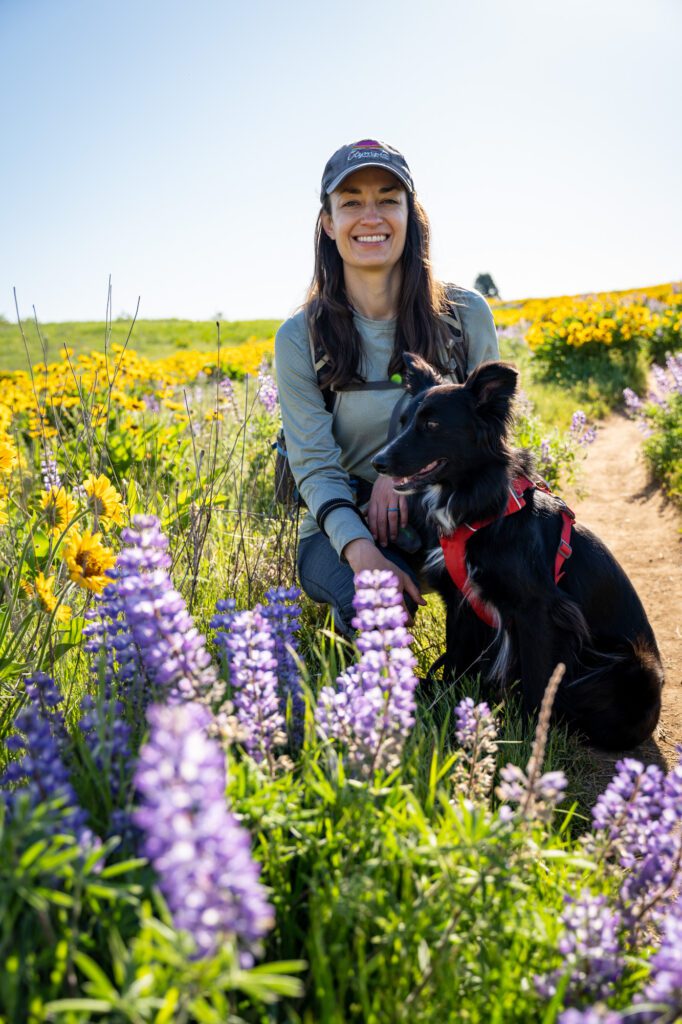
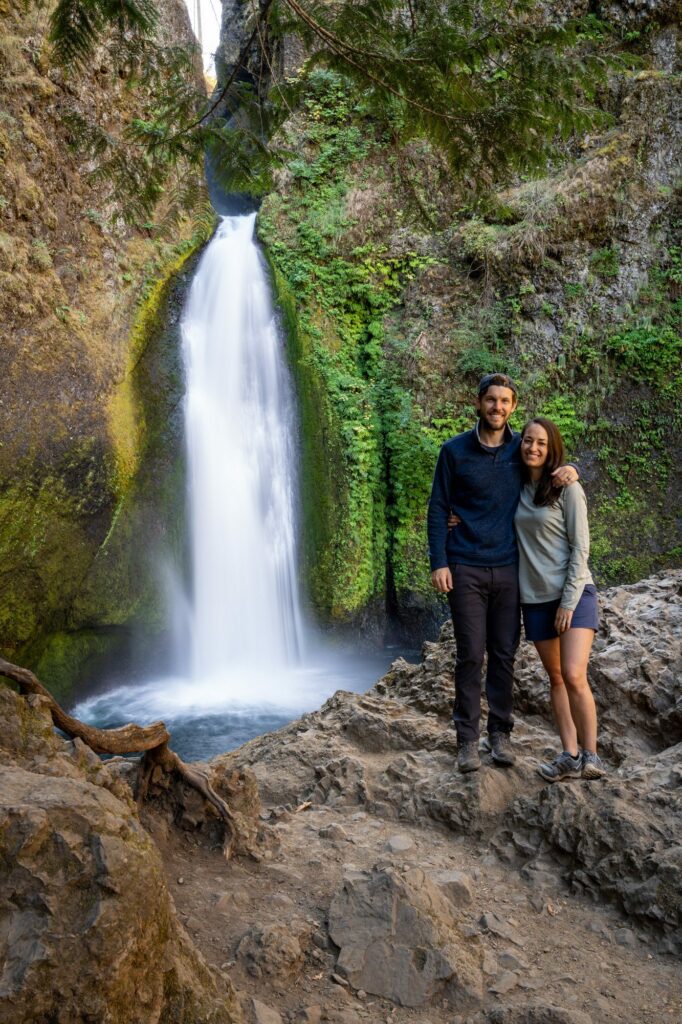
Disclaimer: Some of the links in this post, like hotel links, are affiliate links, meaning at no additional cost to you, we make a little bit of money if you click through and book. That being said, we would never recommend something to you that we don’t stand behind 100%.
A Quick Portland Geography Overview
Before we get into the guide, we think it’s worth taking a second to talk about Portland’s geography and where it sits in the northwest corner of Oregon.
First, let’s talk about Portland.
Portland itself is a relatively compact city with TONS of green spaces, which is part of the reason why we love living here.
Broadly speaking the city is split in half by the Willamette River, which runs right through the middle of Portland and separates the more urban west side from the more residential eastside.
However, despite our characterization of the west side of the river as more urban (it’s where you’ll find Portland’s downtown core), most of Portland’s best hikes are actually on that side because both Washington Park and Forest Park (among others) are in the hills just above the city center.
Now let’s talk about the geography of the broader area around Portland.
Portland sits in the northwest corner of Oregon, about 15-20 minutes from the border of Washington State, situated between the Cascades to the east and the coast to the west.
Another big part of the reason we love Portland is the fact that, within 90 minutes, you can be either in the mountains (at Mount Hood, which is southeast of Portland), in the high desert in the Columbia River Gorge (which is northeast of Portland on the Washington border), or on the Pacific Ocean (west of Portland).
It’s an unparalleled access to a diverse range of landscapes within an hour and a half of the city, which you’ll see reflected in the list of hikes below.
No matter which direction you drive out of Portland, there are going to be some great hikes.
The Best Hikes near Portland (Within 90 Minutes)
And now, let’s get into the hikes themselves!
If you’re looking to escape the city and get further out into nature, we have some absolutely fantastic news for you.
There is perhaps no better place to do that than Portland, where you have the mountains, the Columbia River Gorge, and the Oregon Coast within 90 minutes or so.
But if you’re not up for a day trip, Portland also has some great hikes, both within its city limits, and within a short drive of the city center.
We’re going to organize this guide by distance from Portland, with the closer-in hikes at the beginning (including the hikes that are actually within the city limits – we currently have nine of them), working our way outward to hikes that are a longer trip (but only the ones that we think are worth the trip).
One thing to know about hiking trails in Portland: in places like Forest Park, Mt. Tabor, and Tryon Creek State Park, there’s a nearly endless combination of trails, weaving through the forest, across creeks, and to various viewpoints.
Below, we’ve given you our picks for the loops we liked, but know that you can make each of them shorter or longer according to what you’re looking for.
Because we’re giving you this list in order of distance from Portland, we want to make sure we also give you our picks for the “best” of the list below depending on what you’re looking for.
Here’s a quick summary, and you can read the more in-depth trail guides below for more information.
- If you’re looking for a great hike in Portland’s city limits (that is accessible without a car), we’d hit either the Washington Park Loop or the hike from Lower Macleay Park to Pittock Mansion.
- If you’re looking for an amazing waterfall hike, we’d do the Trail of Ten Falls (in Silver Falls State Park) or Wahclella Falls (closer to Portland and an easier hike – the best bang-for-your-buck in the Gorge, we think). Tamanawas Falls is also worth a mention, but it’s further from the city on the opposite side of Mount Hood (so it doesn’t quite make the 90 minute cutoff).
- If you’re in the mood for sweeping vistas, we’d do either McNeil Point (an epic, very difficult climb at Mount Hood), Angel’s Rest (a more accessible trail with nice Gorge views), or Saddle Mountain (a coastal climb with views of distant peaks).
- If you’re hunting for wildflowers in the spring, the Coyote Wall Trail, Dog Mountain, and Memaloose Hills are where we’ve seen spectacular fields of flowers ourselves.
The Washington Park Loop
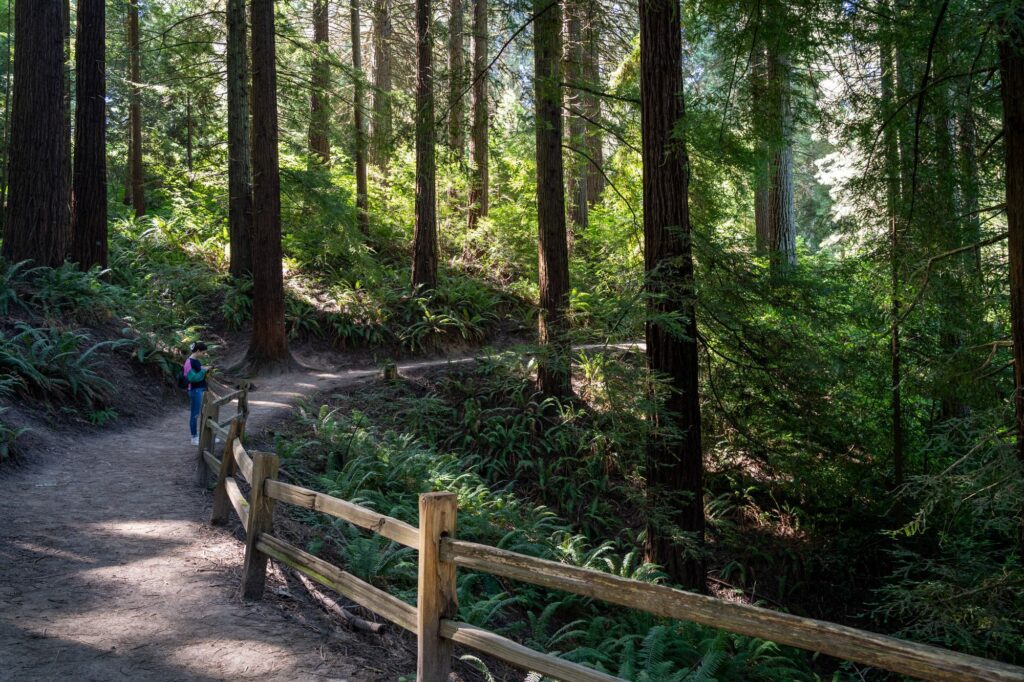
- Length: 4.8 miles
- Elevation Gain: 750 ft.
- Trail Type: Loop
- Difficulty: Easy / Moderate
- Pass Required? None (paid parking in Washington Park)
- Dog-Friendly? Yes, on a leash
- Trailhead Location: Washington Park
Now, there are a nearly unlimited number of ways to combine the trails in Washington Park – which is just above Downtown Portland in the hills – into a nice hike.
However, we think this version of the hike is the ultimate loop, because it includes all of our favorite parts of the park (namely the Hoyt Arboretum, the Rose Garden and Japanese Garden) into one manageable loop.
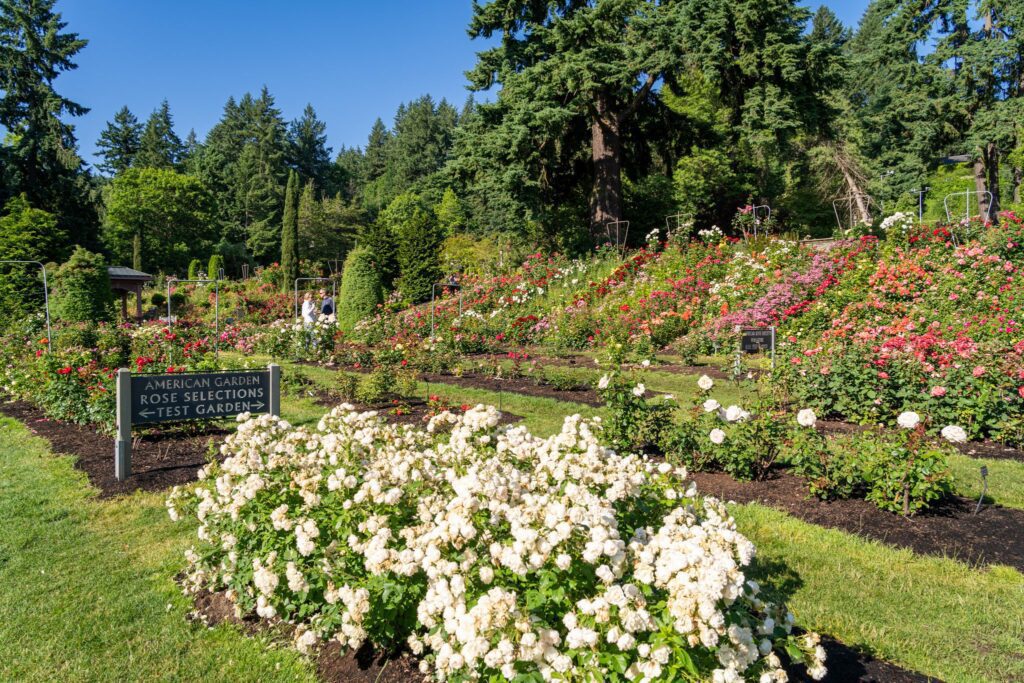
Along the way, you’ll also see the archery range in the park, the Japanese Garden, the Vietnam Veterans of Oregon Memorial, and plenty more.
There are a couple of different ways to do this hike, and it basically comes down to whether you’re driving or not, and whether you want to pay for parking or risk not finding a spot.
Here’s the quick breakdown:
- If you don’t have a car: Take the MAX Line (red or blue) to the Oregon Zoo / Washington Park stop, and start / end the loop there. You could also walk up the hill to the rose garden from the Northwest District if you were feeling extra energetic.
- If you have a car, and are willing to pay $8 for parking: Park at either the Rose Garden or the Zoo.
- If you’re cheap and want free parking: Park on Fairview Blvd – roughly here – and start the loop there heading in either direction.
The Lower Macleay Trail to Pittock Mansion
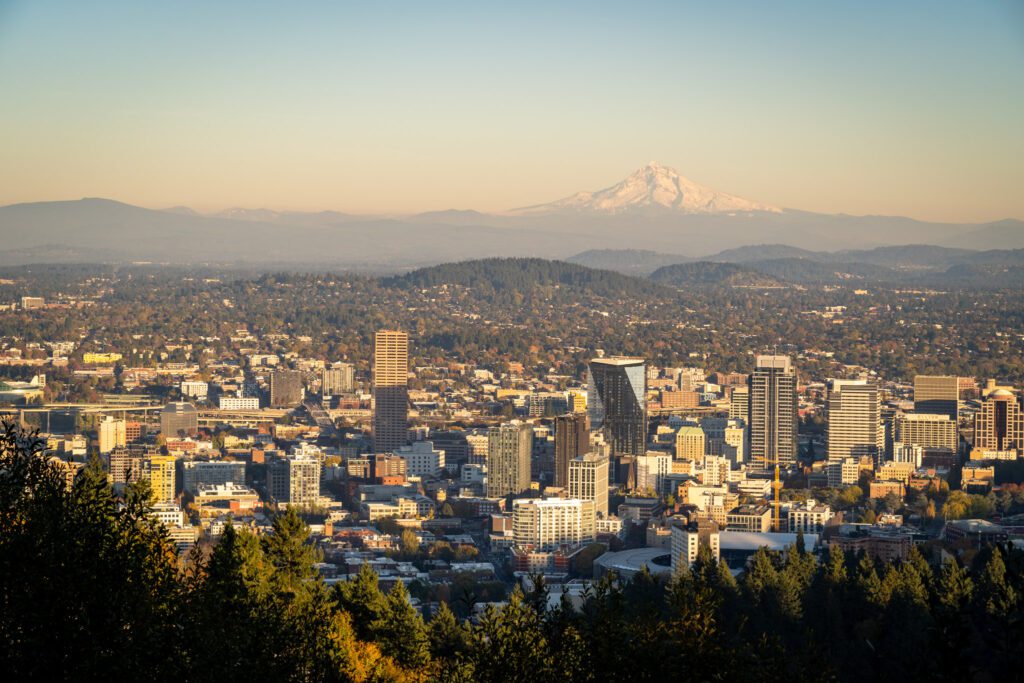
- Length: 5 miles
- Elevation Gain: 950 ft.
- Trail Type: Out and Back
- Difficulty: Moderate
- Pass Required? None
- Dog-Friendly? Yes, on a leash
- Trailhead Location: Lower Macleay Park
If you only have time for one hike while you’re in Portland, this is our choice for you.
It starts from the Lower Macleay Trailhead in northwest Portland, where there are bathrooms and a small parking lot.
From the trailhead, you’ll head into the heart of Forest Park, starting with a flat, meandering walk along the creek.
About a mile in, you’ll hit the Witch’s Castle, which is a spooky looking building that used to be a ranger station and restroom, but was destroyed in the 60’s and never rebuilt.
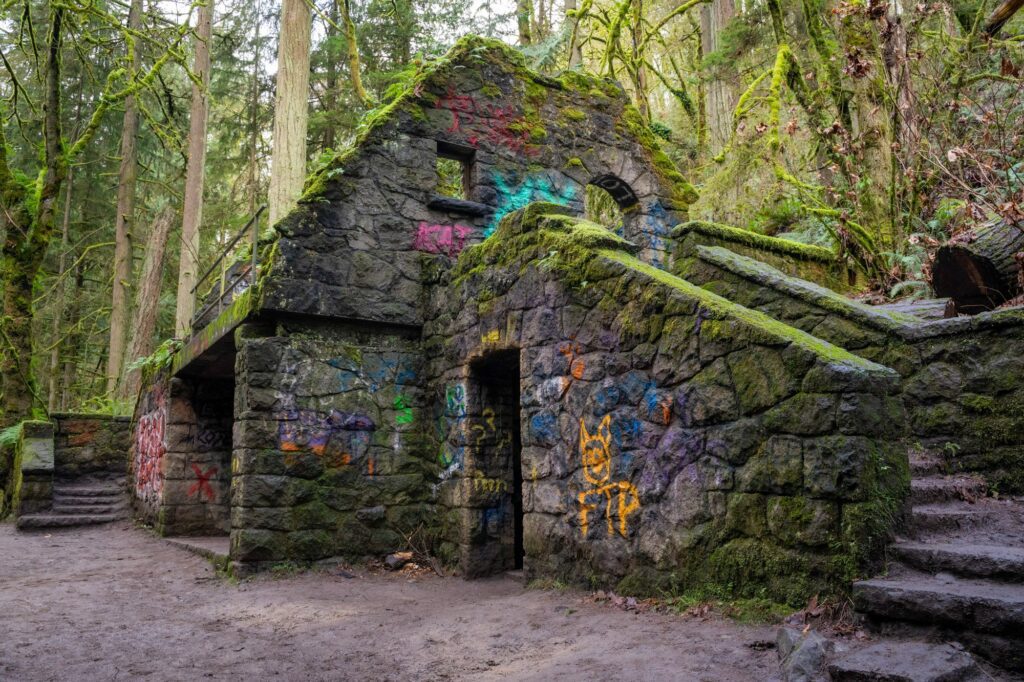
Today, it’s Insta-famous, with all sorts of graffiti covering nearly every surface. It’s very…odd. Peak Portland.
After spending a second there, continue along the trail, which becomes the Wildwood Trail (which runs more than 30 miles end-to-end through Washington and Forest Park).
You’ll cross a bridge spanning the creek, and that’s where the climbing starts in earnest. It’s all uphill from here!
You’ll climb some switchbacks up to the Upper Macleay parking lot, where you’ll need to cross the road, and start up even more switchbacks on the other side.
It’s a good climb, and you’ll probably be breathing a little bit harder when you arrive at Pittock Mansion than the people who are getting out of their cars after driving there.
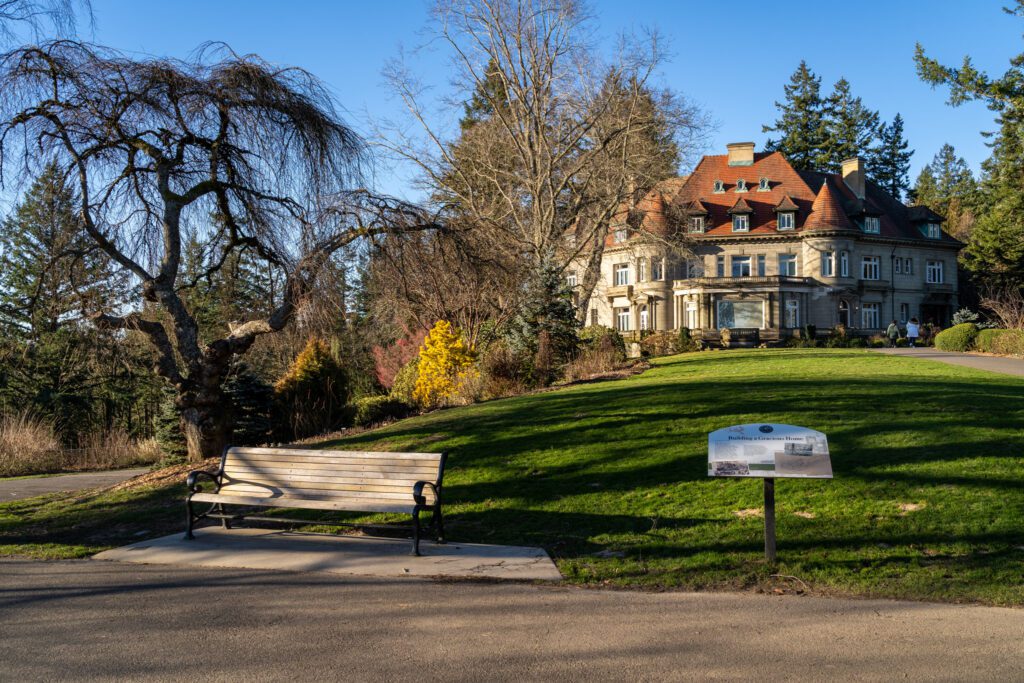
Admire the views, check out Pittock Mansion, and head back down the way you came when you’re done.
You could do this two other ways, depending on what you’re looking for.
- To make it shorter, start at the Upper Macleay Trailhead (here on Google Maps), but know that you’ll miss the Witch’s Castle.
- Do it one way from the trailhead to Pittock Mansion and continue into Forest Park and over to the International Rose Test Garden and Hoyt Arboretum. Just get a Lyft (or a ride) to the trailhead.
Note that the parking lot at the trailhead is small, but there’s plenty of street parking in the adjacent neighborhood if it’s full when you get there.
Read More: The Hike to Pittock Mansion – A Helpful Trail Guide
The 4T Trail
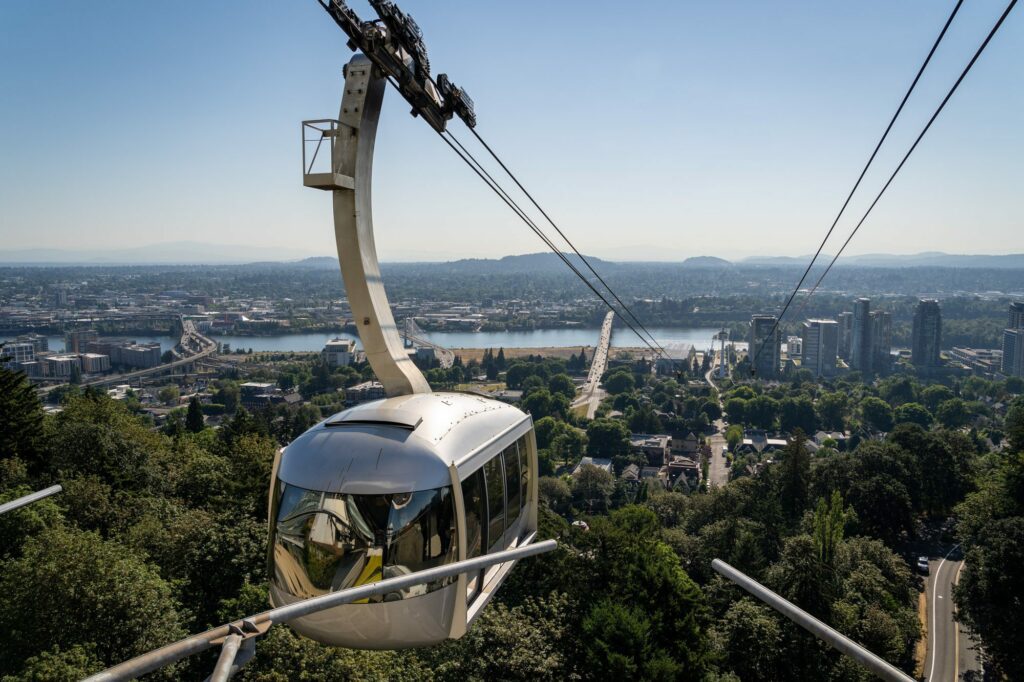
- Length: 4.2 miles (this is the hiking portion of the trail)
- Elevation Gain: 600 ft.
- Trail Type: Loop
- Difficulty: Easy / Moderate
- Pass Required? None (though you will pay for parking)
- Dog-Friendly? No dogs allowed (because of public transportation)
- Trailhead Location: Oregon Zoo
This is one of the more unique hikes available in the city limits of Portland. If you follow the 4T trail, you’ll make a giant loop around downtown Portland, using four different modes of transportation (trail, tram, train, trolley) to navigate the city.
It was one of the first hikes we did upon moving to Portland, and it’s a fun experience to share with visitors because you see the city from different angles than you usually would.
Plus, the view from both Council Crest Park and the Portland Aerial Tram are spectacular.
Tackling this trail was a little complicated, and we found it hard to find reliable information on the internet helping us figure out things like where to start, what direction to go, and other important logistical questions.
So we wrote a guide! If you’re interested in this hike, you should read our guide to hiking the 4T Trail.
Here’s the summary. Begin at the Oregon Zoo and start a forested climb up to Council Crest Park where, on a clear day, you can see multiple snowy peaks like St. Helens and Mount Hood.
Head down the Marquam Trail to the top of the Portland Aerial Tram, where you’ll embark on a scenic three minute journey down to the river level.
From the base of the Aerial Tram, hop on the Portland Streetcar and head downtown. To complete the loop, take the MAX back to the Oregon Zoo (although, if you’re starting from downtown Portland, you’ll start with the MAX ride to the zoo).
All in, it will cost you between $8 and $11 to do this trail, which covers the aerial tram and tickets on the MAX and Streetcar (or a day pass) – not including parking at the zoo if that’s how you do it.
There’s more to it, so we’d really encourage you to read our guide to the 4T trail to figure out exactly how to do the hike!
The Powell Butte Loop Trail
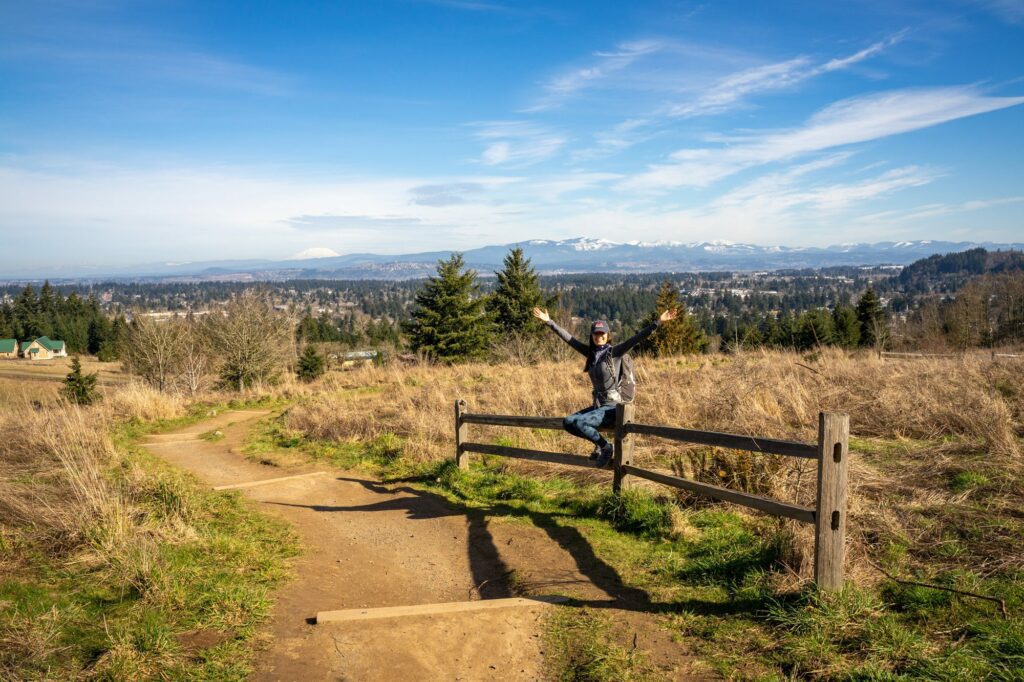
- Length: 4.1 miles
- Elevation Gain: 554 ft.
- Trail Type: Loop
- Difficulty: Easy / Moderate
- Pass Required? None
- Dog-Friendly? Yes, on a leash
- Trailhead Location: Powell Butte Nature Park
This hike is best on a clear day, because from the summit of Powell Butte, which is an extinct volcano, you can see Mount St. Helens, Mount Hood, AND Mount Adams.
On our last visit, we saw a clear day in the forecast, woke up to some sun, and booked it out to the trailhead before the precious winter sun went away.
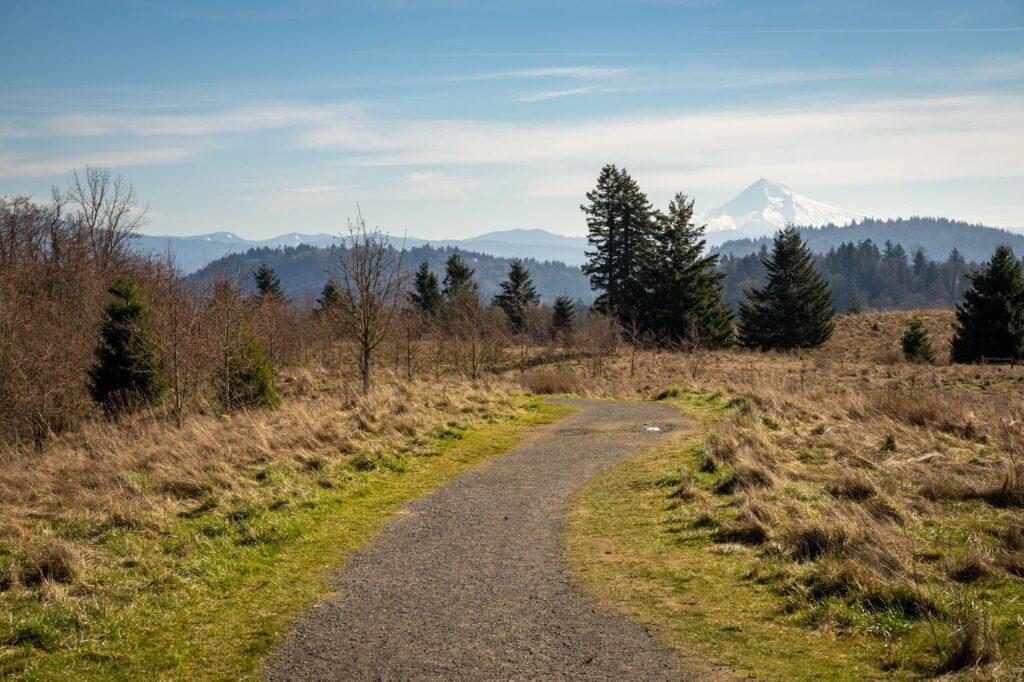
Now, there are many, many variations of this hike because Powell Butte has a robust network of trails.
We like this version of the loop, which skirts the perimeter of the park and has some nice forested sections interspersed with exposed sections with nice views of the snowy peaks of Hood and St. Helens.
The hike starts from a relatively small trailhead with plenty of parking for a weekday, but I’m sure it gets packed on weekends.
You’ll follow a wide, paved path along the northern edge of the park before taking a right at the fork to take Holgate Lane, which leads you down into the forested area.
Meander through the ferns and tall trees before taking a left up the stairs and connecting with the Elderberry Trail, which is where the hike gets very woodsy, and connect with first the Cedar Grove Trail, then the Hawthorne Trail, which leads you most of the way around the western edge of the park and ends at the Summit Trail.
From there, make the return down to the parking lot after you spend some time admiring the views of the different mountains in all directions.
It’s a good urban hike in Portland, and like most of the parks in Portland, there’s a nearly endless number of trails that you can connect and explore, so hiking here never gets old.
The Mount Tabor Blue Loop
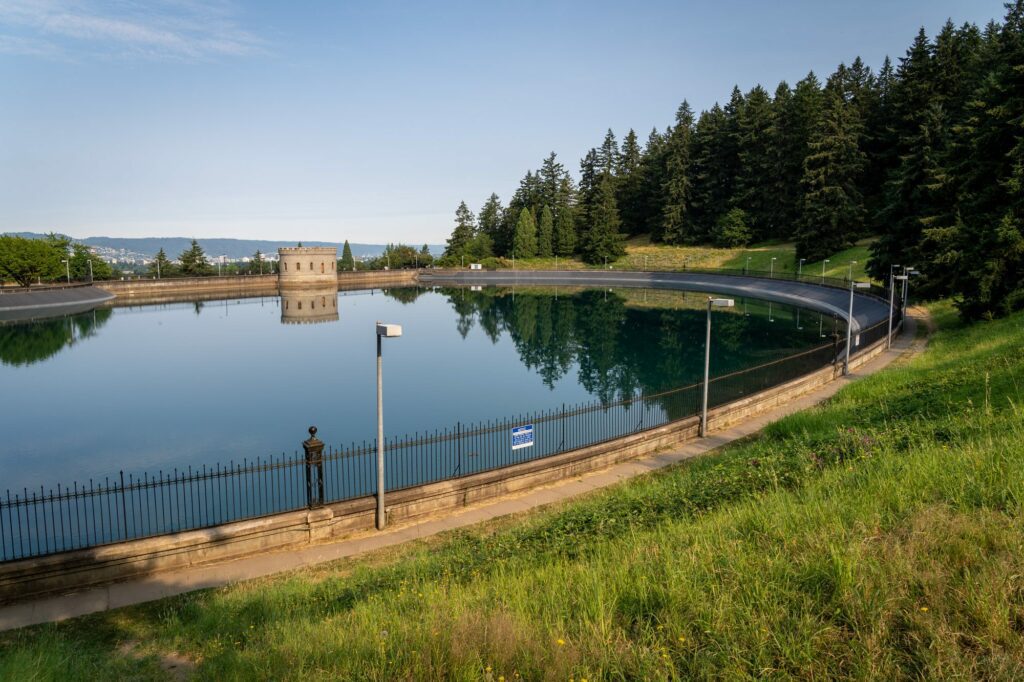
- Length: 2 miles
- Elevation Gain: 250 ft.
- Trail Type: Loop
- Difficulty: Easy
- Pass Required? None
- Dog-Friendly? Yes, on a leash
- Trailhead Location: Mount Tabor Visitors Center
Mount Tabor is an extinct volcano in southeast Portland, and from viewpoints on the west side you can get a nice vista of downtown Portland.
Like a lot of the other parks in Portland, there’s a nearly endless number of different hiking trails you could combine here, and we usually find ourselves doing something like the red loop (here’s a map of the park), which takes you to the best views (from the top of the stairs next to reservoir #5), and the perimeter trail which is a little quieter.
You can also do the Blue Loop, which is just over a mile and takes you up to the summit, down to the southwest side of the park around the two reservoirs, and back up to the summit before returning to your car.
You can combine parts of the Blue and Green Trails to do a slightly longer loop – roughly two miles – that takes you around the entire boundary of the park in a big loop.
The color coded markers along the trail make it fairly easy to figure out where you’re going.
In terms of parking, we almost always park in the neighborhood on the western end of the park (roughly here on Google Maps) and walk up past reservoir #6 to the top of the stairs to start the hike.
The Hoyt Arboretum Loop
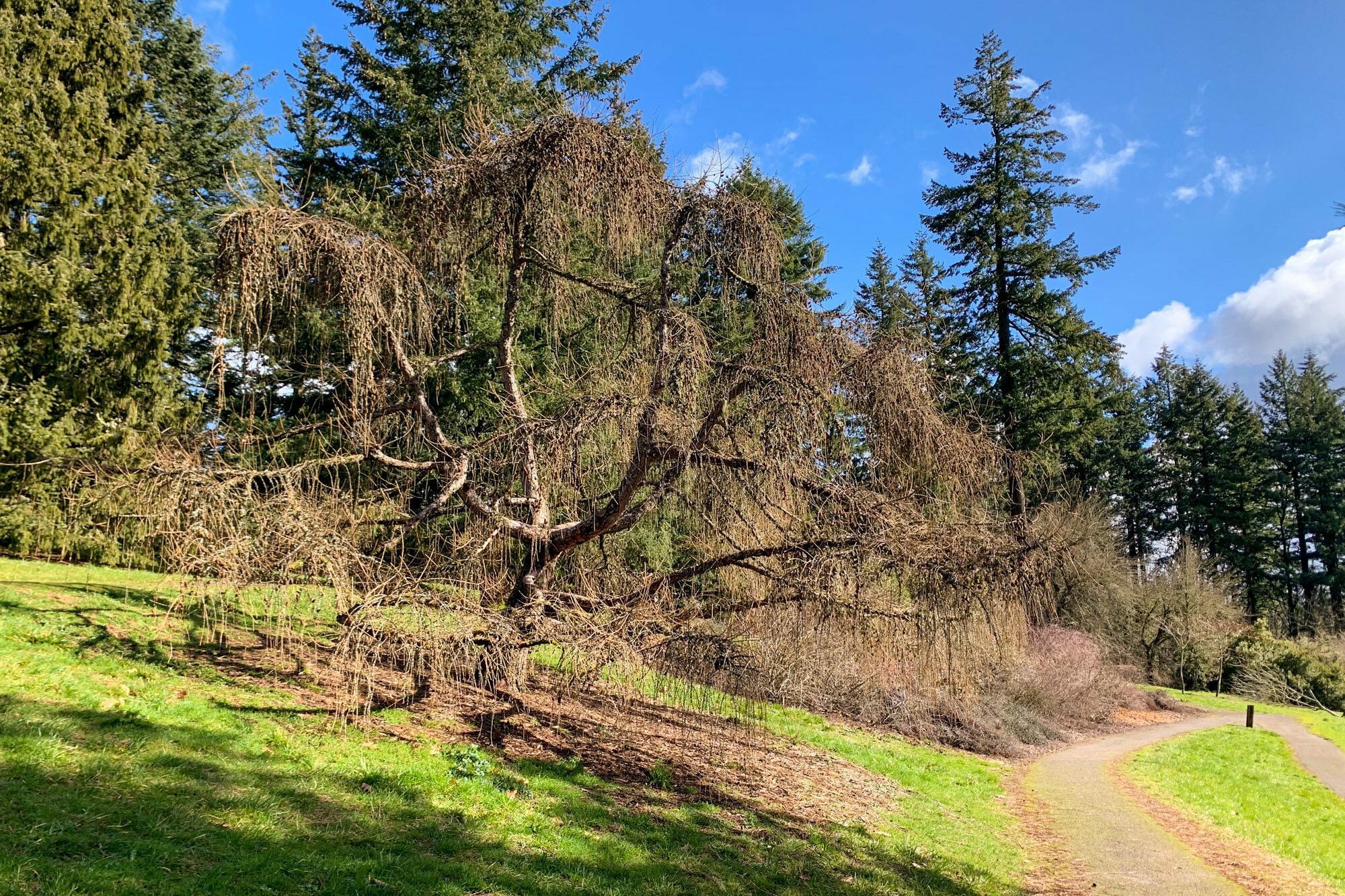
- Length: 2.4 miles (ish)
- Elevation Gain: 400 ft.
- Trail Type: Loop
- Difficulty: Easy
- Pass Required? None
- Dog-Friendly? Yes, on a leash
- Trailhead Location: Hoyt Arboretum Visitors Center
Did you know that an arboretum is like a botanical garden, but just for trees? Me neither.
In the Hoyt Arboretum, they have 6,000 trees of more than 2,000 different species! You’ll see redwoods, spruce, and a magnolia collection, among other things.
Once again, the Hoyt Arboretum has a nice network of 12 miles of hiking trails in it, so there are various ways to combine them into an easy loop hike.
You can find a park map here, which has three hikes to start with.
In terms of specific hikes, this is a good route to cover the northwestern half of the Arboretum (which includes the photogenic Redwood Deck).
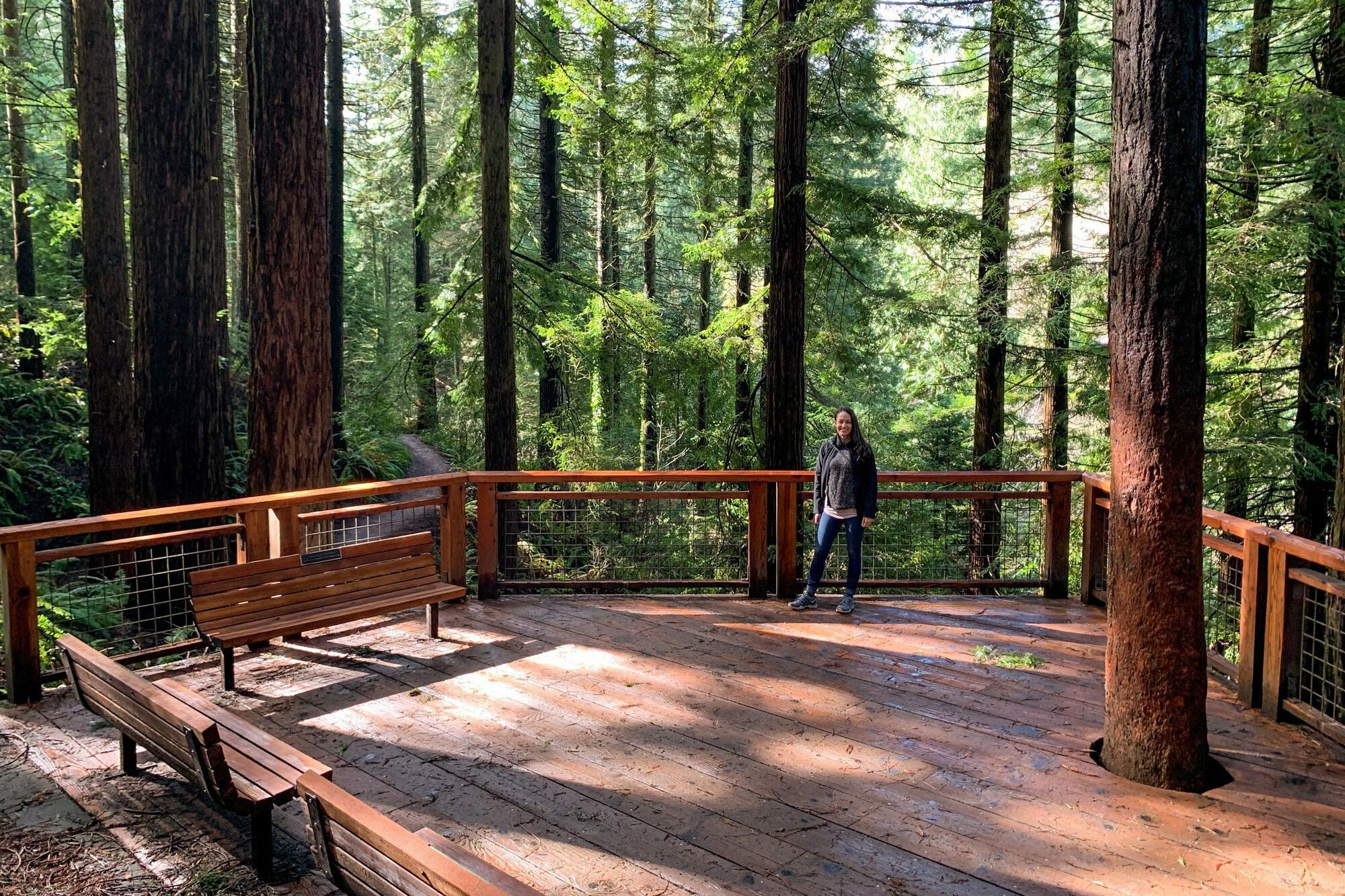
If you’re up for something longer, we’d recommend combining that “1 hour loop”, which takes you to the gorgeous Redwood Deck, and along the Spruce and Redwood sections, and the 2 hour loop, which takes you along the south end of the park, for a total of 2.4 miles.
There are tons of interpretive signs along the trail – make sure to stop along the way to learn about all the different species of trees and shrubs you’re passing.
Parking will cost you $2 per hour at the trailhead (machines take cards, or you can use Parking Kitty, Portland’s official parking app), but you can also park along the road pretty much anywhere there’s not a “no parking” sign for free.
Marquam Trail to Council Crest Park
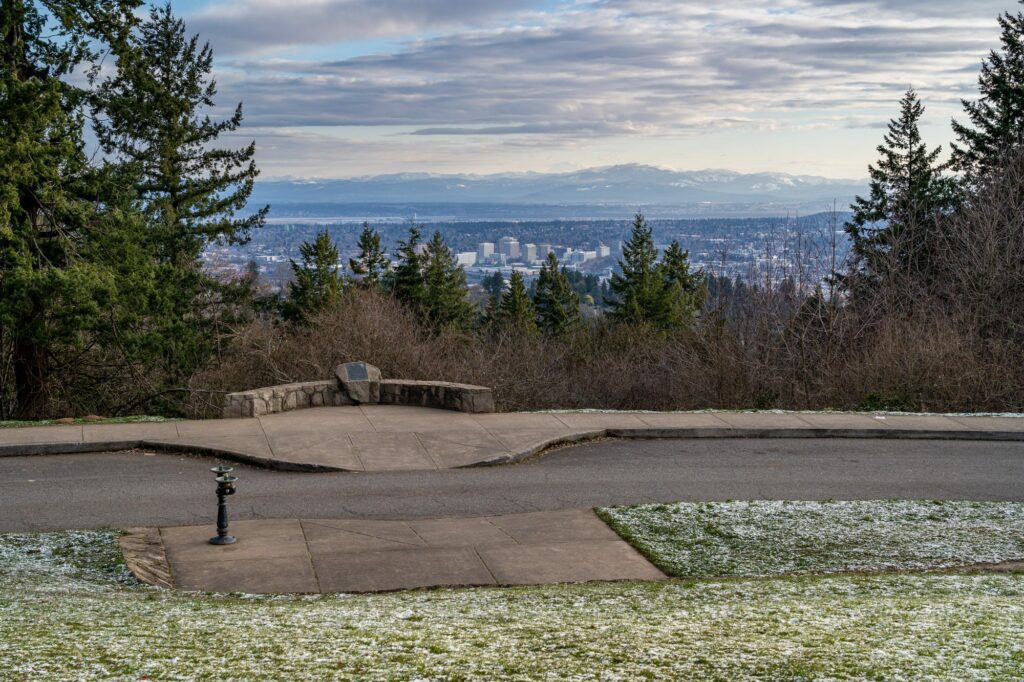
- Length: 3.1 miles
- Elevation Gain: 750 ft.
- Trail Type: Out and Back
- Difficulty: Moderate
- Pass Required? None
- Dog-Friendly? Yes, on a leash
- Trailhead Location: Marquam Trail Public Parking
This is our favorite section of the 4T trail, which is why it makes the list here!
You’ll start from the trailhead in Marquam Nature Park, and embark on a semi intense climb through old growth forests to an excellent viewpoint up at Council Crest Park.
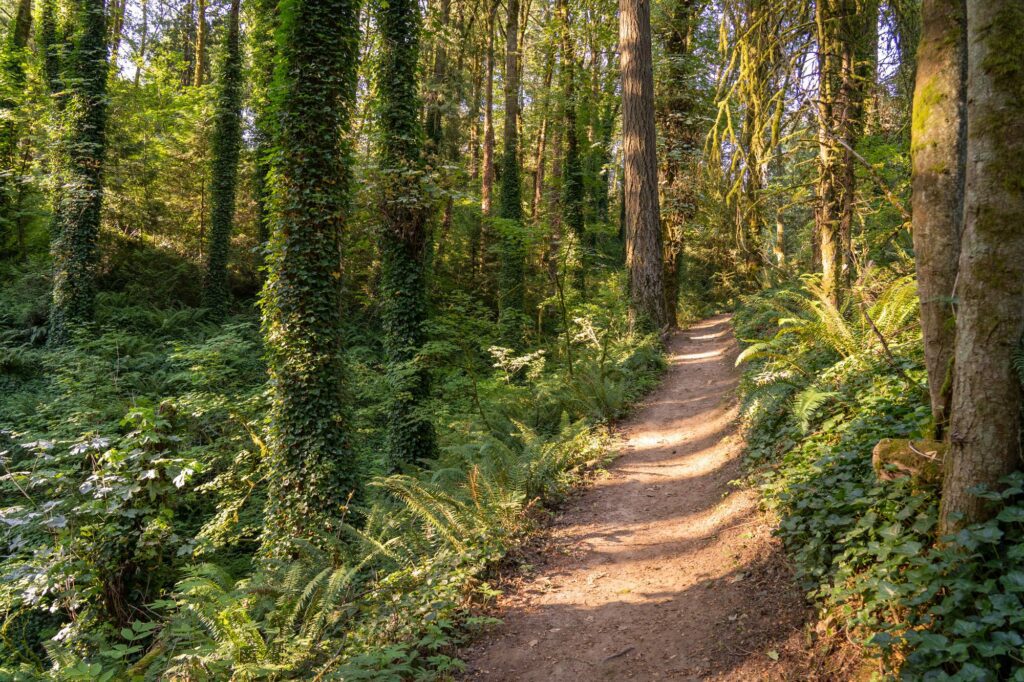
From Council Crest, you can see north to Mount St. Helens, and east to Mount Hood. This is a great sunset spot, so we’d recommend doing this hike in the afternoon if you can swing it.
If you don’t have a car and still want to do this trail, taking the Portland Aerial Tram up and back down is actually a great option to reach the trailhead.
It adds about a mile and 250 feet of climbing (on the way back to the tram), but it’s a beautiful view from the top station of the tram.
The Forest Park Ridge Trail
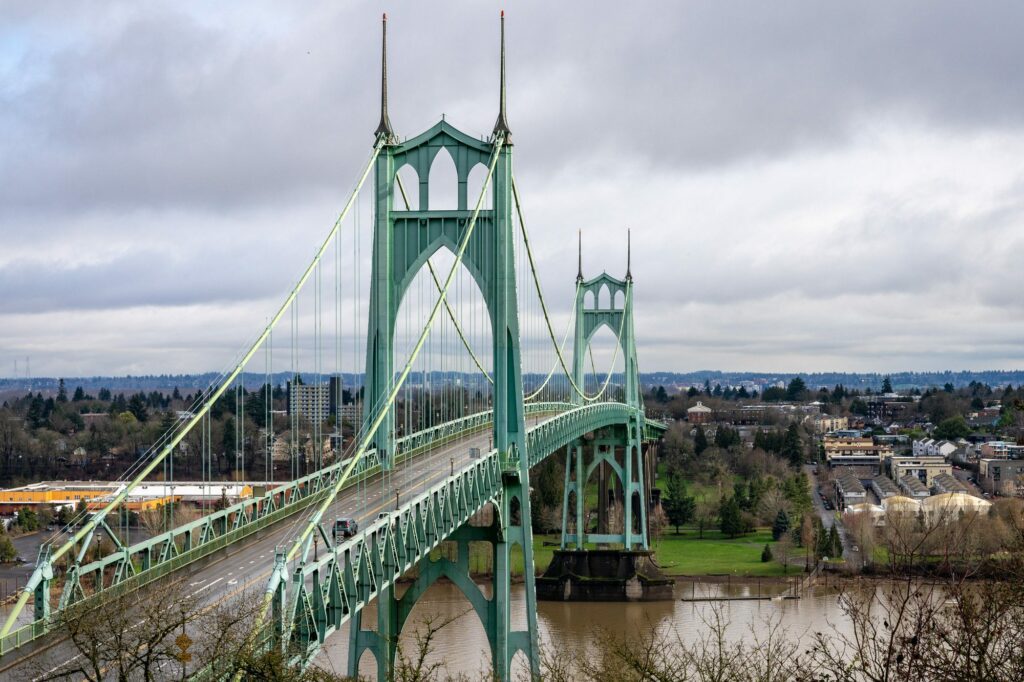
- Length: 4 miles
- Elevation Gain: 850 ft.
- Trail Type: Out and Back
- Difficulty: Moderate
- Pass Required? None
- Dog-Friendly? Yes, on a leash
- Trailhead Location: Springville Road Trailhead
This hike is on this list purely for the excellent view of the St. John’s Bridge and Mount St. Helens at the beginning of the hike (if you do it from the bottom, anyway).
Which brings us to an important note – the parking lot at the bottom of the hike is BARELY a parking lot (it’s more like a pull off), and has no services (no bathroom, no sidewalk to the start of the trail).
A better option is to start at the top of the ridge from this parking lot off of Skyline Blvd and make your way down to the viewpoint before hiking back up.
Aside from that excellent view, it’s a relatively quiet, moderately challenging walk in the woods, which is particularly nice in the spring and early summer when the ferns are green and the flowers are blooming.
The Tryon Creek Triple Bridge Loop
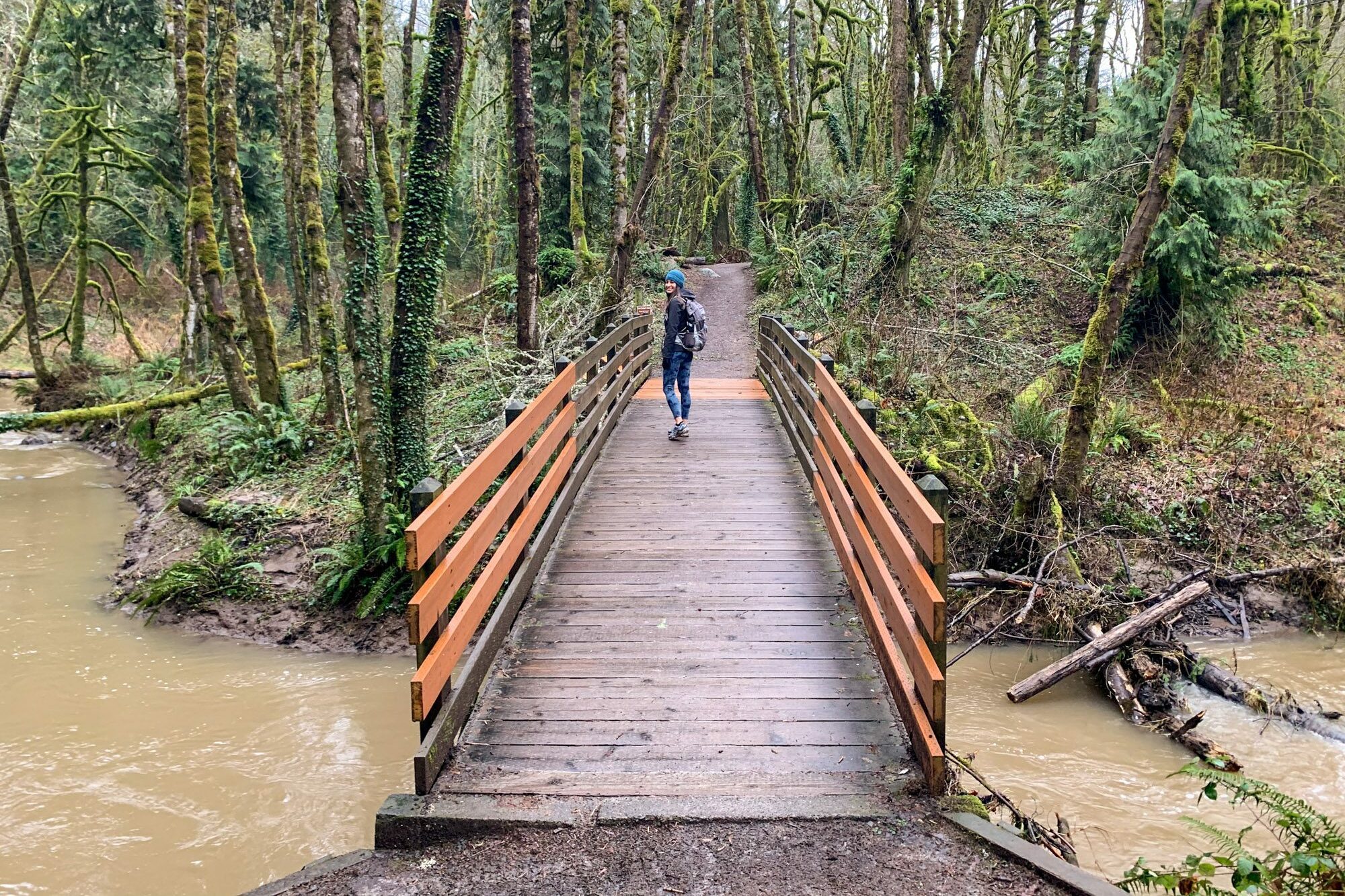
- Length: 3.5 miles
- Elevation Gain: 541 ft.
- Trail Type: Loop
- Difficulty: Easy
- Pass Required? None
- Dog-Friendly? Yes, on a leash
- Trailhead Location: Friends of Tryon Creek
Fun fact: this was our first ever hike in Portland’s city limits, and it didn’t disappoint. It was a gray winter day, and it was foggy and lightly misting, but that didn’t stop us from hitting the trail.
It’s crazy that this is in Portland, because it feels like you’re out deep in the woods (aside from when you randomly pass houses next to the trail).
You’ll meander through the forest, crossing several bridges over the creek, and gently climbing and descending with the rolling hills.
It was actually pretty pleasant in the rain, although it was muddy in spots.
This is another good all-season hike because in the offseason, you get some vibrant green ferns along the lush forest floor, and some flowers blooming in the spring.
Then, in the summer and fall, it’s completely forested, so you get nice shade coverage.
Thing to note: When we were there last, the Terry Riley Bridge at the northern end of the loop was closed, but you can do the North Horse Loop instead.
Angel’s Rest (Columbia River Gorge)
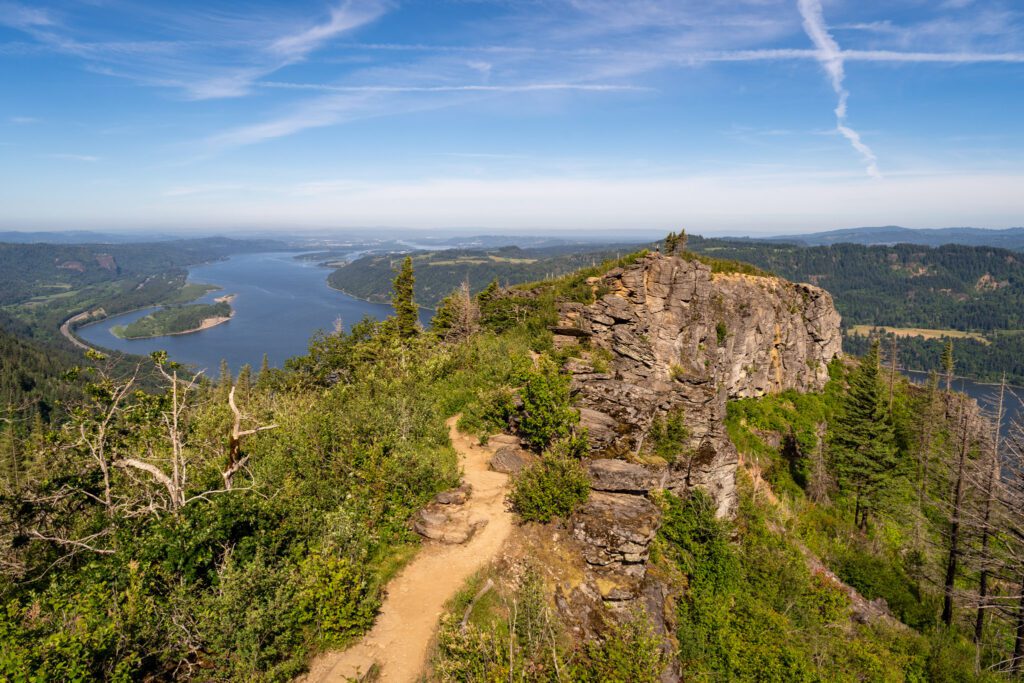
- Length: 4.5 miles
- Elevation Gain: 1,500 ft.
- Trail Type: Out and Back
- Difficulty: Moderate
- Pass Required? Northwest Forest Pass
- Dog-Friendly? Yes, on a leash
- Trailhead Location: Angel’s Rest Trailhead
- Drive Time / Distance from Portland: 30 minutes / 27 miles
Unlike most of the hikes on the Oregon side of the Gorge, this one offers great views of the Gorge itself (rather than the waterfalls), which is what we associate more with the hikes on the Washington side.
It’s a climb to get up to Angel’s Rest, but it’s well worth the effort when you’re sitting at the ledge overlooking the Gorge.
It starts from the Angel’s Rest Trailhead, roughly 30 minutes outside of Portland.
You’ll embark on a series of switchbacks interspersed with steadier climbs for the first mile and a half, with a few points where you have a preview of the view of the Gorge you get from the top.
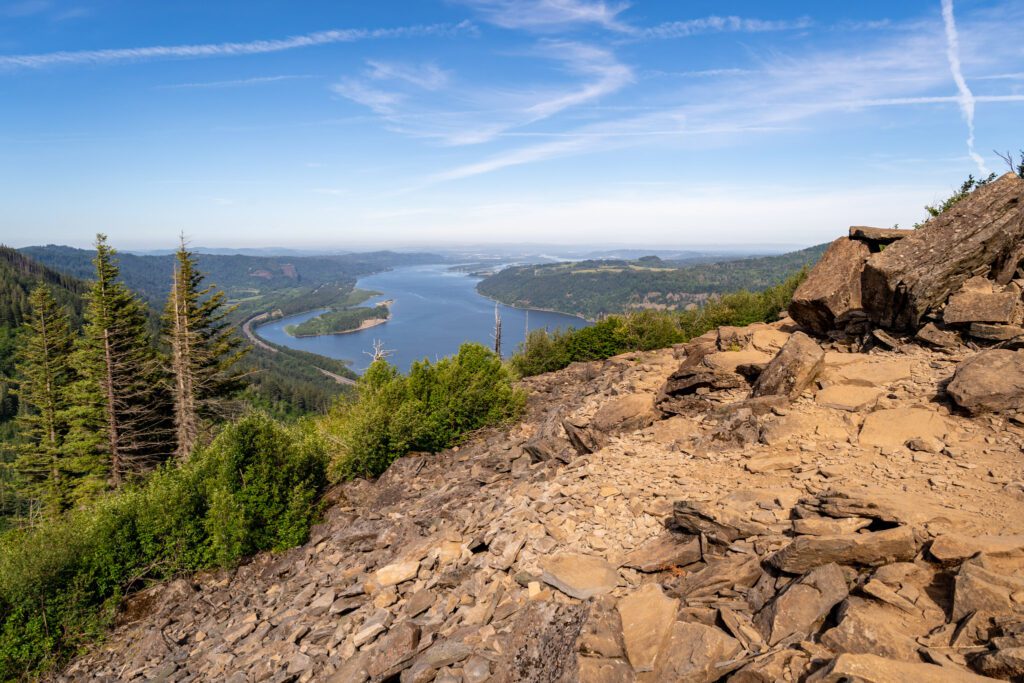
At 1.5 miles in, the trail turns into tight switchbacks as you make the final ascent to the top. You’ll cross a mini boulder field that is really nothing to be concerned about, and then find yourself at an intersection of trails, which is a little confusing.
Follow the trail out towards the river for a bit and you’ll arrive at the viewpoint.
It’s a pretty constant climb from the trailhead to the top, so you’ll need to be prepared for that.
It also was somewhat muddy, and there were remnants of snow left over from a recent snowstorm when we hiked it in February, so it’s worth being prepared for ice and snow if you’re hiking it in the dead of winter.
Waterproof hiking boots and trekking poles will be useful here.
Latourell Falls (Columbia River Gorge)
- Length: 2 miles
- Elevation Gain: 650 ft.
- Trail Type: Loop
- Difficulty: Easy / Moderate
- Pass Required? None
- Dog-Friendly? Yes, on a leash
- Trailhead Location: Latourell Falls Trailhead
- Drive Time / Distance from Portland: 35 minutes / 30 miles
This is a great add-on to the hike at Multnomah Falls we’re about to mention below.
It’s a short two mile loop with a little bit of climbing along the way, but it’s pretty accessible for most hikers, which is why we bring a lot of out-of-town visitors here.
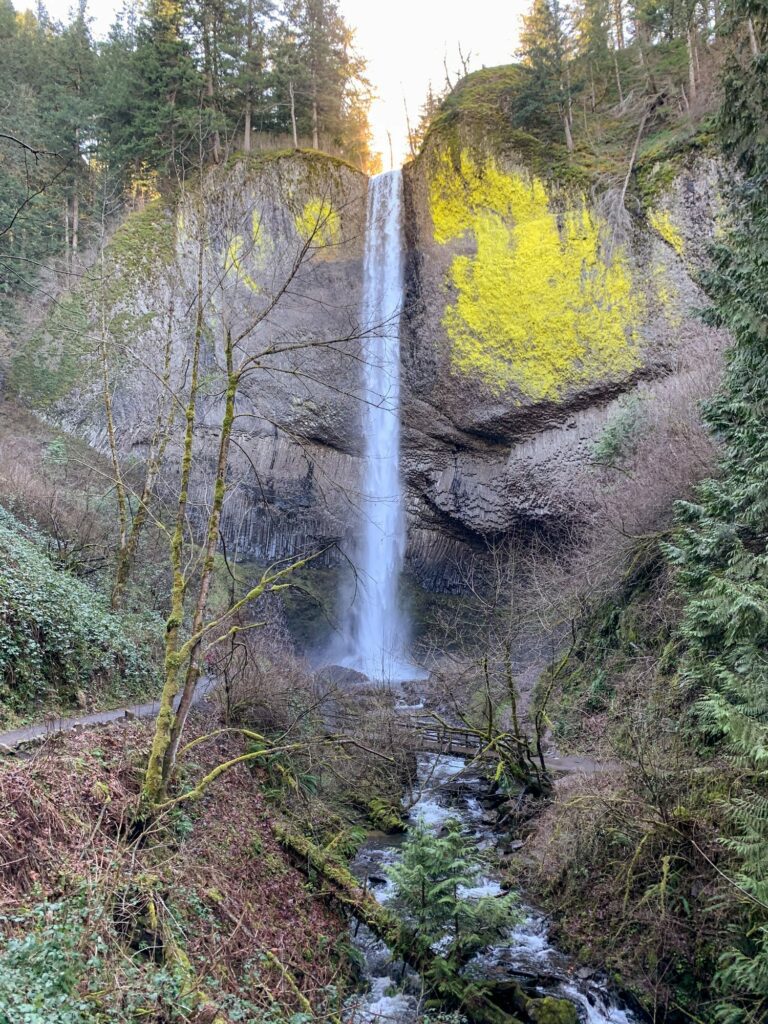
The trailhead is also just off of the Historic Columbia River Highway, which is a fun drive to do on your way out to the Gorge.
Make sure to stop at the Vista House and Scenic Women’s Forum Viewpoint for some excellent views of the Gorge!
Do this one clockwise. Start with the climb up and to the left of the parking lot, which takes you to Upper Latourell Falls, a unique waterfall with two distinct levels.
Then, you’ll loop down and around to the Lower Falls, which is the real stunner.
It’s a 249 foot tall waterfall, which is nothing when you compare it to Multnomah Falls, but is certainly impressive when you consider it in its own right.
At one point near the end of the loop, you’ll come to the road. If you turn right here, it takes you back to the parking lot across a bridge. DON’T DO THAT.
Instead, cross the road and follow the trail under the bridge and to the base of the falls. You can get there either way, but this is the way you should do it.
Multnomah and Wahkeena Falls (Columbia River Gorge)
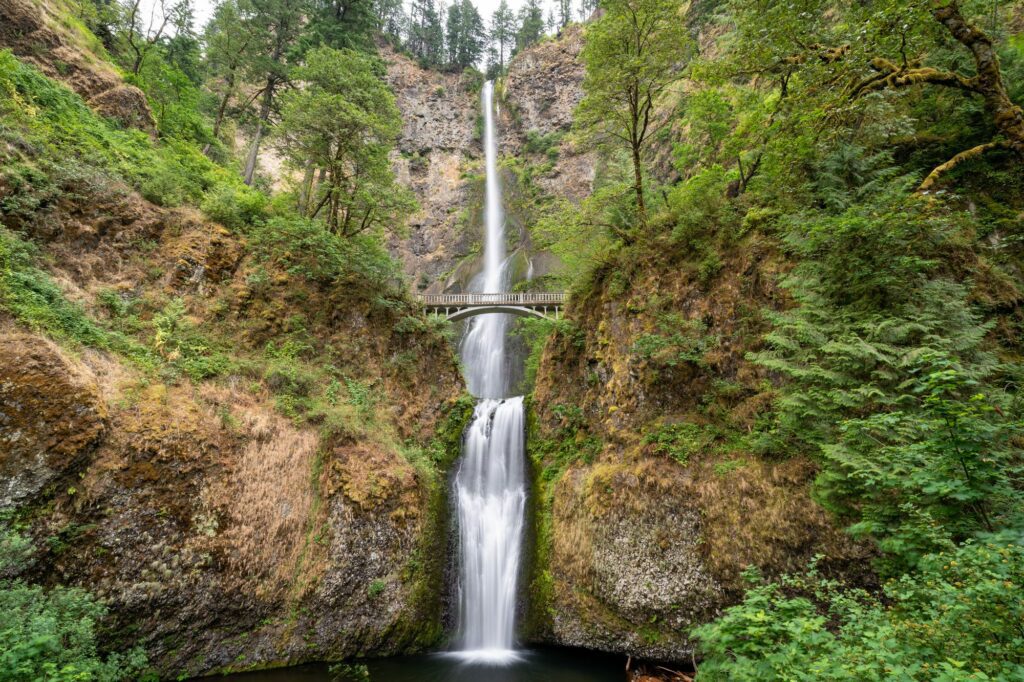
- Length: 5.6 miles
- Elevation Gain: 1,800 ft.
- Trail Type: Loop
- Difficulty: Moderate
- Pass Required? None
- Dog-Friendly? Yes, on a leash
- Trailhead Location: Multnomah Falls Trailhead
- Drive Time / Distance from Portland: 35 minutes / 30 miles
Multnomah is the king (or queen) of the waterfalls in the Columbia River Gorge.
It’s a whopping 600+ feet tall, and should absolutely be at the top of your list of day trips from Portland – it’s about 40 minutes outside of the city.
Most people walk up to the viewpoint on the bridge, head back to their cars, and head home.
But we think you should put on your hiking boots, strap on your daypack, and do the loop up and around Multnomah, passing nearby Wahkeena Falls on your way back.
Because Multnomah Falls is so popular, you’re going to want to do this one early in the day to get a parking spot and beat the crowds. Plus, the falls itself is so much more peaceful without hundreds of people jockeying for the best photo spot.
We recommend doing this trail clockwise, starting with the climb up to the top of Multnomah, then hitting Wahkeena on the way back down.
The trail starts up the switchbacks to the left of the falls, aggressively climbing 700 feet over the course of a mile. When you reach the top of Multnomah Falls, there’s a nice viewpoint that’s worth a quick detour.
The trail continues climbing over the next mile and a half or so, and you’ll pass multiple smaller falls along the way.
Eventually, you’ll reach the high point, which isn’t marked or really all that special, and it’s all downhill from there.
You’ll pass Fairy Falls on the switchbacks on the way down, and then Wahkeena Falls at the base of the trail.
From there, you’ll follow a mostly flat trail along the side of the road back to your car at Multnomah.
Read More: Hiking the Multnomah – Wahkeena Falls Loop Trail (Helpful Trail Guide)
The Warrior Rock Lighthouse Trail (Sauvie Island)
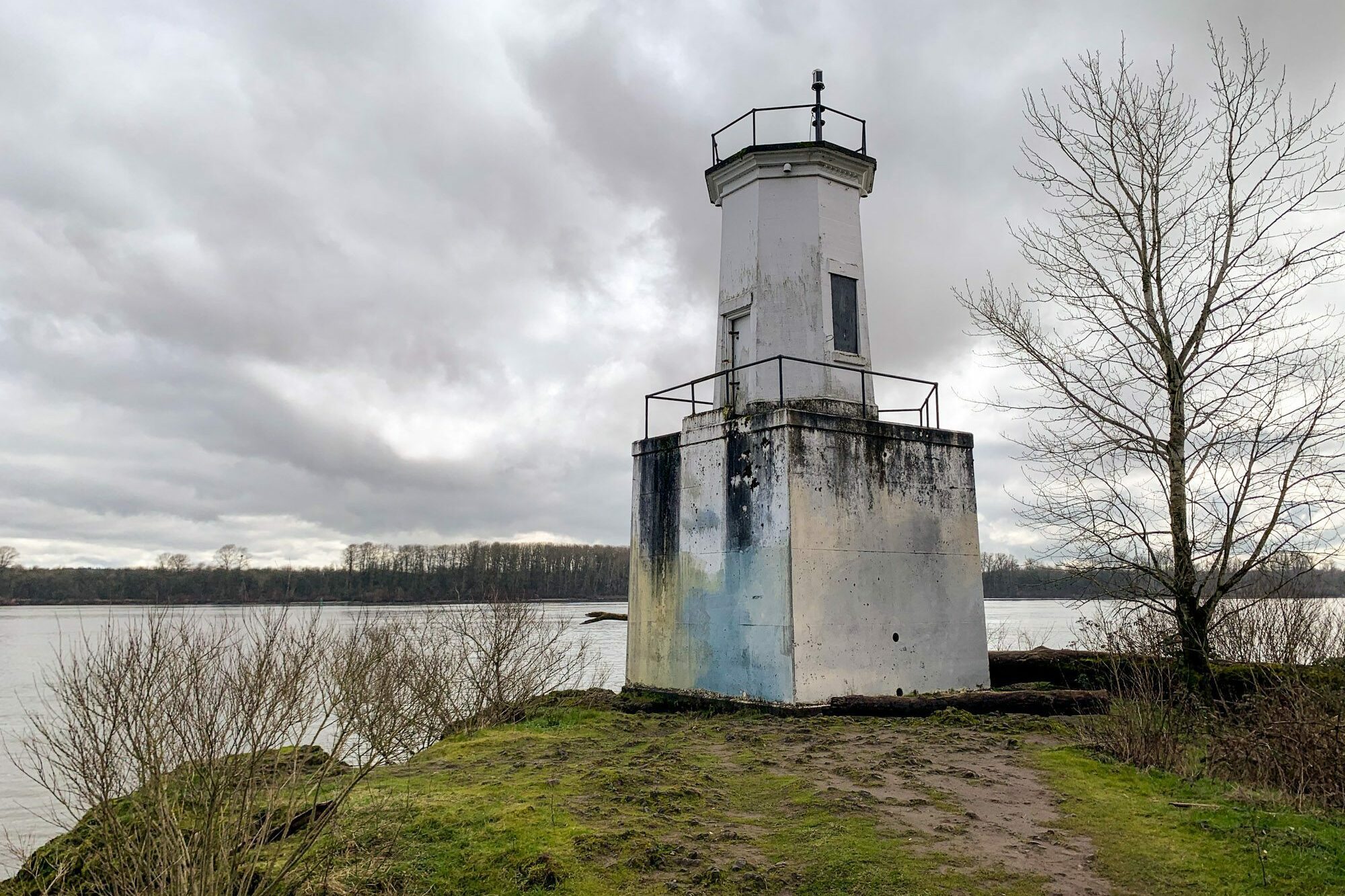
- Length: 6.1 miles
- Elevation Gain: 62 ft.
- Trail Type: Out and Back
- Difficulty: Easy
- Pass Required? Sauvie Island Wildlife Refuge Permit
- Dog-Friendly? Yes, on a leash
- Trailhead Location: Warrior Rock Lighthouse Point Trailhead
- Drive Time / Distance from Portland: 45 minutes / 26 miles
This hike is at the north end of Sauvie Island, which takes a while to get to from Portland.
However, once you’re on Sauvie Island, you might just forget that you’re anywhere near a big city as you drive past farm after farm, with bald eagles sitting high in the trees, and all sorts of amazing birds hanging out around the island.
We like doing this in the winter, when the trees are bare and you can see the bald eagles. We saw SIX on our last foray out here in the winter.
IMPORTANT: There’s plenty of parking at the trailhead, though you will need to buy a Sauvie Island recreation permit, which you can get at these locations (we got it at Cracker Barrel right as you come across the Sauvie Island Bridge from Portland). Buy it BEFORE you head out to the trailhead, otherwise you’ll have to double back a long way. It’s going to cost you $10 for the day, or $30 for an annual pass.
The hike out to Warrior Point Lighthouse is an easy, family-friendly one. It’s essentially flat, though it is 6 miles there and back.
One thing to note – This hike can be SUPER muddy in the winter, so don’t wear your new white Nikes on this one.
The Lighthouse itself is nice, and the beach nearby is worth stopping on for a rest and a snack before you head back the way you came.
Wahclella Falls (Columbia River Gorge)
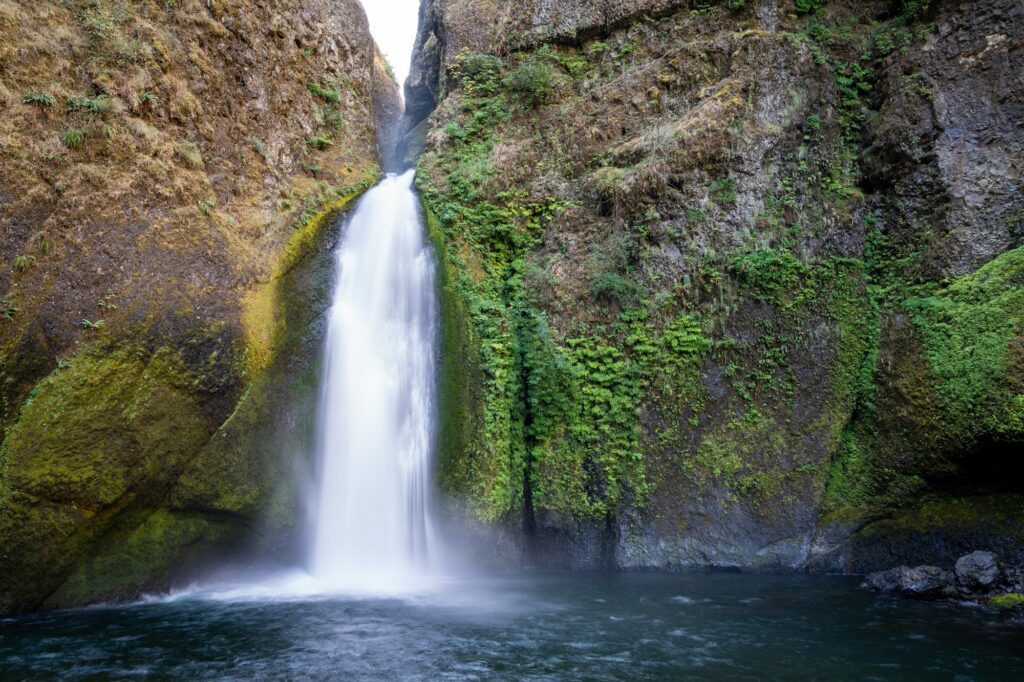
- Length: 1.9 miles
- Elevation Gain: 308 ft.
- Trail Type: Lollipop
- Difficulty: Easy
- Pass Required? Northwest Forest Pass
- Dog-Friendly? Yes, on a leash
- Trailhead Location: Wahclella Falls Trailhead
- Drive Time / Distance from Portland: 45 minutes / 40 miles
This might be the best bang-for-your-buck hike in the Gorge (if you’re looking for a great waterfall) when you also consider the number of people that hike this trail compared to the ones closer to Portland (like Latourell or Multnomah).
Plus, the relatively small parking lot at the trailhead (there’s room for seven ish cars) serves as an artificial limit on the number of hikers (though you can just park at the overflow lot here and walk along the footpath to the trailhead if there isn’t a spot in the lot).
Once you’re on the trail, it’s a nice and easy lollipop out to the waterfall. We’d do it counter-clockwise so that you’re hiking up the Gorge towards the falls, taking the higher path back (where there aren’t really any views to be had).
As you hike, if you look up to the higher slopes of the Gorge you’ll see evidence of the very sad Eagle Creek Fire that swept through this part of the Gorge a few years ago.
Read More: Hiking the Wahclella Falls Trail in the Columbia River Gorge
Dog Mountain (Columbia River Gorge)
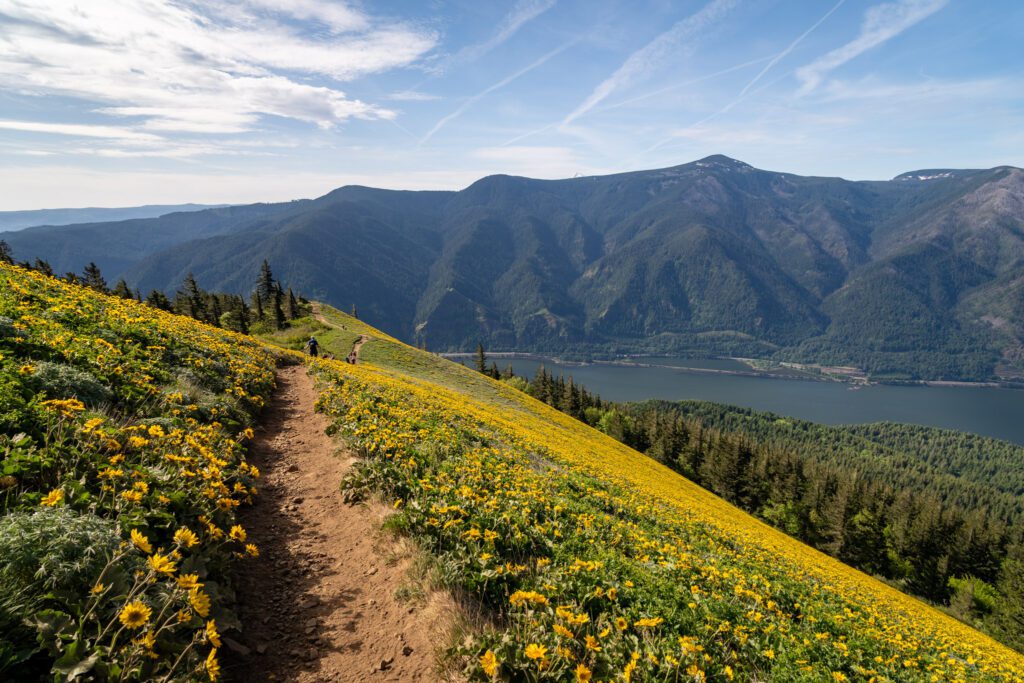
- Length: 7.4 miles
- Elevation Gain: 2,800 ft.
- Trail Type: Loop
- Difficulty: Moderate / Hard
- Pass Required? Northwest Forest Pass (plus additional weekend permit in spring / summer)
- Dog-Friendly? Yes, on a leash
- Trailhead Location: Dog Mountain Trailhead
- Drive Time / Distance from Portland: 1 hour / 55 miles
Dog Mountain is on the Washington side of the Gorge, which means it’s a little harder to get to from Portland than many of the hikes above, which are mostly on the Oregon side (except for Cape Horn).
However, if you’re up for a tough hike, this is worth the journey.
It’s pretty much an uphill slog the entire way up, but the views of the Columbia River Gorge from the top and, if you hit it at the right time, the spectacular bounty of wildflowers along the way, make the juice worth the squeeze.
We first did this hike on a beautiful summer morning, and got to the top only to find one big poof of fog shrouding the summit.
Despite the fact that we sat up in the cold, wet mist for ten minutes to see if it would break, we still loved this hike.
There’s an excellent viewpoint just below the summit that was not obscured by fog, and the views along the trail nearby are special.
This hike is incredibly busy in the months of May and June, as the wildflowers start to pop in the Columbia River Gorge.
There is now a permit system that is required to park at the trailhead on weekends during the summer months. You can find more details here.
Read More: Hiking the Dog Mountain Trail in the Columbia River Gorge
Ramona Falls (Mount Hood)
- Length: 7.1 miles
- Elevation Gain: 1,000 ft.
- Trail Type: Lollipop
- Difficulty: Easy / Moderate
- Pass Required? Northwest Forest Pass
- Dog-Friendly? Yes, on a leash
- Trailhead Location: Ramona Falls Trailhead
- Drive Time / Distance from Portland: 1 hour 15 minutes / 52 miles
Yet another spectacular waterfall hike within 90 minutes of Portland! This one is a relatively easy hike that takes you to a cascading falls that tumbles 120 feet into the creek below.
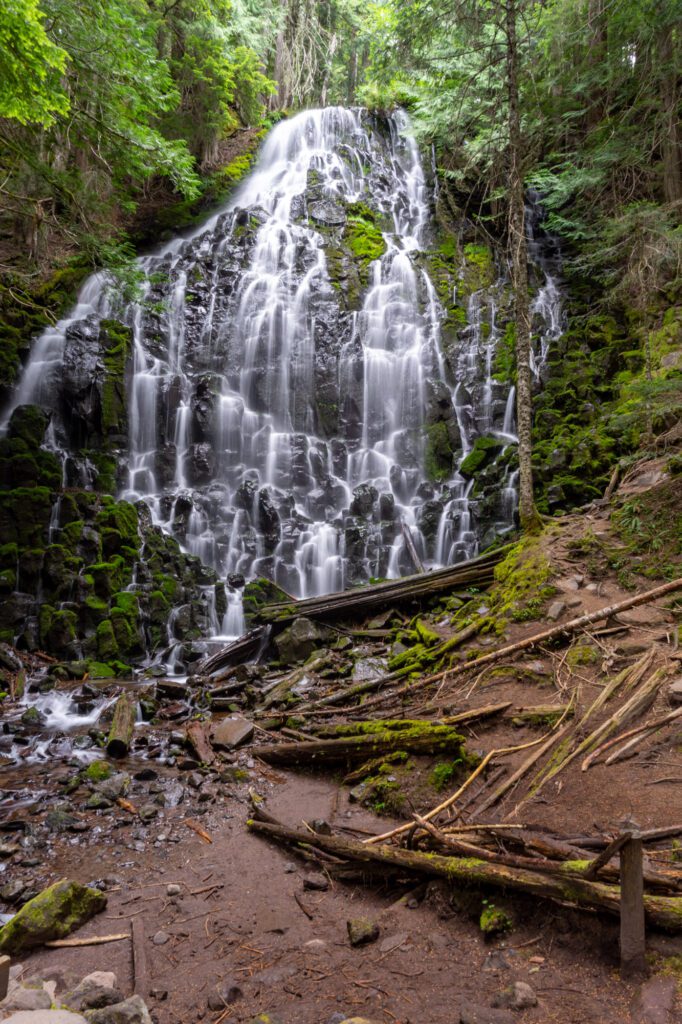
However, rather than a waterfall like Multnomah Falls, which is cool because of the volume and power of water, the beauty of Ramona Falls is the snaking, silky streams of water that create a wall of cascades.
It’s pretty spectacular, and is different from most of the waterfalls in the Gorge and down at Silver Falls.
By far the hardest part about this hike is crossing the Sandy River. There used to be a seasonal bridge across the river, setup by the Forest Service.
But after years of washing out, they decided to stop placing the bridge going forward, so it’s up to you to find a log to use to traverse the Sandy River.
When it’s really moving – spring and early summer – it can be treacherous. And it creates a bottleneck on the trail when people are slowly crossing.
If you’re not stoked about crossing the river, and are comfortable adding a little over a mile on either end of the hike, you can start from the Top Spur Trailhead instead.
That route takes the river crossing out of it (though there is still a much more manageable creek crossing you’ll have to do), but adds quite a bit of distance and elevation gain.
Tom, Dick, and Harry Mountain (Mount Hood)
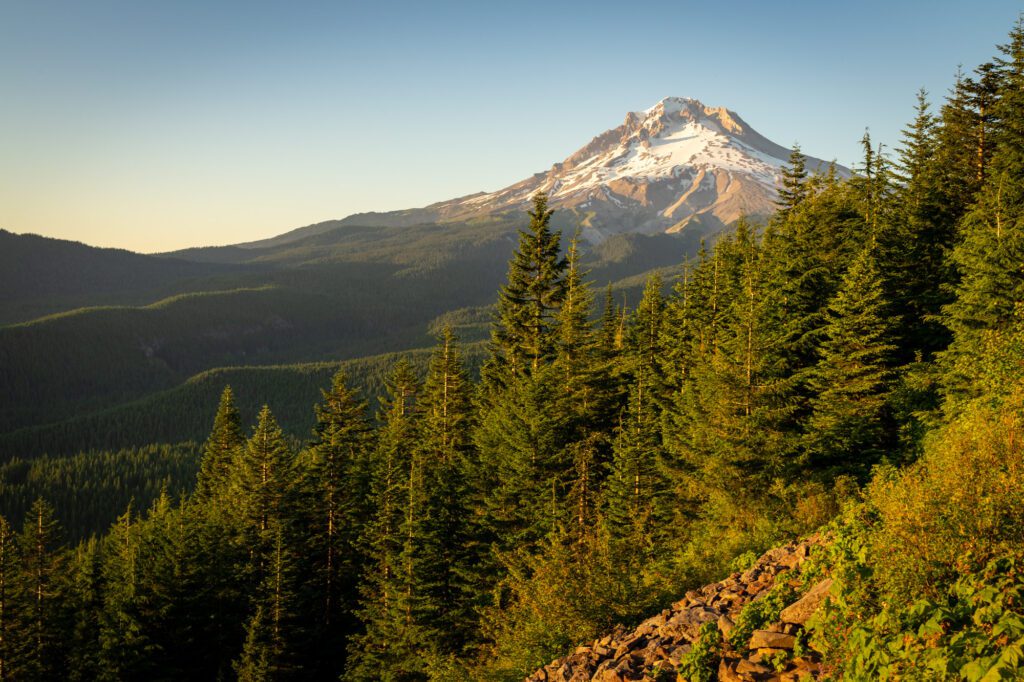
- Length: 9 miles
- Elevation Gain: 1,700 ft.
- Trail Type: Out and Back
- Difficulty: Moderate / Hard
- Pass Required? Northwest Forest Pass
- Dog-Friendly? Yes, on a leash
- Trailhead Location: Mirror Lake Trailhead
- Drive Time / Distance from Portland: 1 hour 15 minutes / 55 miles
We’ve now done this hike a couple of times, and it’s both fantastic and surprisingly accessible from Portland.
The Mirror Lake Trailhead is where you’ll want to park, and it’s an hour and 15 minutes from Portland, right off of Highway 26.
Because of that accessibility, this can be a busy trail. Best to either start early in the morning (before 9:00 am) if you’re doing it on a weekend.
Or, do what we’ve done and start later in the afternoon to catch the view of Mount Hood at the top in the soft golden glow of the setting sun. Just make sure to bring a headlamp for the way down!
This trail gets busy because it shares the first half of the trail with a much easier hike up to Mirror Lake, which brings tons of families with kids out on sunny summer weekends to frolic in the lake.
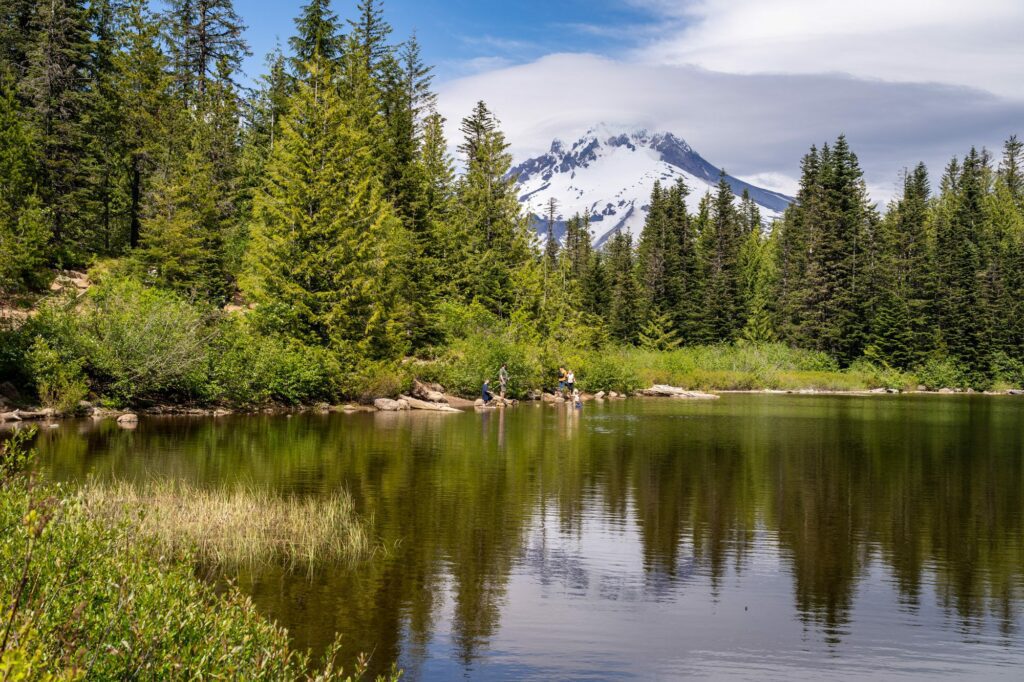
Once you pass the lake – about halfway into the ascent – the crowds thin out and you’ll have the trail mostly to yourself.
The distance above reflects the entire hike to all three peaks (Tom, Dick, and Harry), but most people only go to the first peak, which is the main viewpoint. To that point, it’s eight miles roundtrip.
It’s a rocky plateau with excellent views of Mount Hood’s southern face across the Zigzag Valley, with Mirror Lake in the foreground.
On a clear day, you can also see Mount St. Helens, Mount Adams, and Mount Rainier to the north (barely), and Mount Jefferson to the south.
The last half mile of the ascent requires some scrambling and light route finding as you traverse the ridge. We’ve gone to the second viewpoint, which is worth it to leave the crowds behind and have the view to yourself, but is a little tricky to navigate at times.
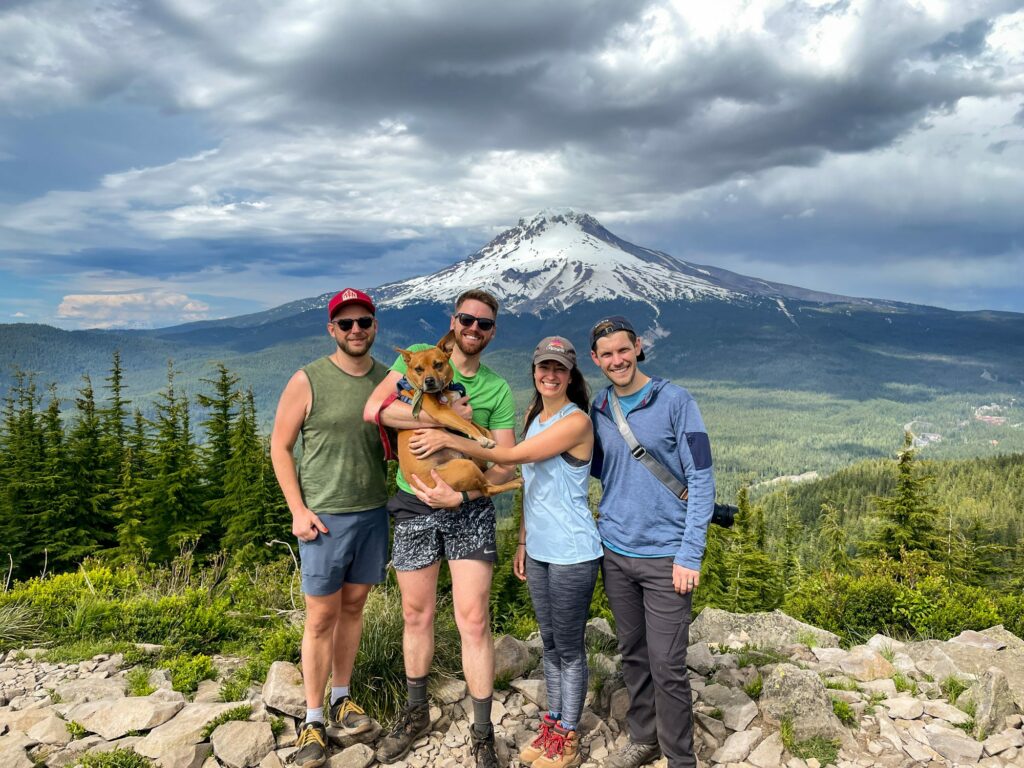
You can also backpack this trail, and sleep up on the ridge (which is something that’s on our bucket list).
Be aware that there are limited opportunities for water once you’re up on the ridge, so fill up down at Mirror Lake.
For more information, including logistics and a trail report, read our guide to Tom, Dick, and Harry Mountain.
Coyote Wall (Columbia River Gorge)
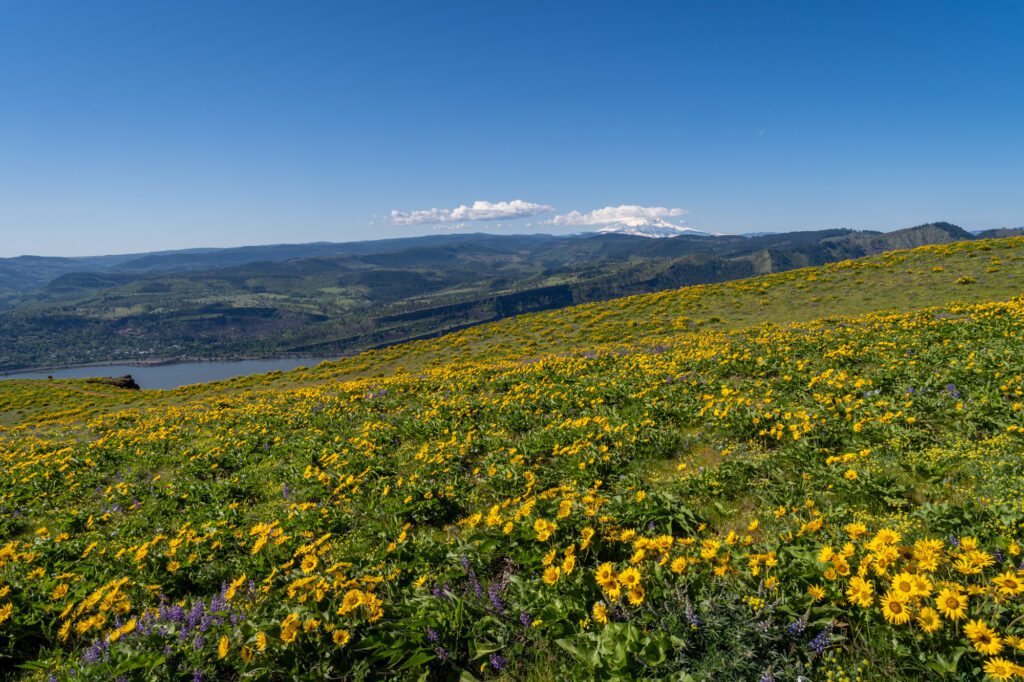
- Length: 7.8 miles
- Elevation Gain: 1,775 ft.
- Trail Type: Lollipop
- Difficulty: Moderate
- Pass Required? None
- Dog-Friendly? Yes, on a leash
- Trailhead Location: Coyote Wall Trailhead
- Drive Time / Distance from Portland: 1 hour 15 minutes / 69 miles
The Coyote Wall trail is an excellent offseason hike that just squeezes in under the 90 minute limit we set at the beginning of this guide, and it may be one of our favorite hikes in the Gorge (definitely on the Washington side) because it has three things going for it.
First, it’s a great hike in the springtime when the wildflowers are blooming, and we’ve been here when it was a sea of yellow balsamroot and purple lupine as far as the eye can see.
Second, great views of Hood from atop the “wall” that the hike is named after AND great views up and down the Gorge.
Third, it’s an all-season hike that is accessible year round, and it’s far enough east in the Gorge that you get some nice sunny days in the winter that can serve as a welcome break from the dreary gray skies in Portland.
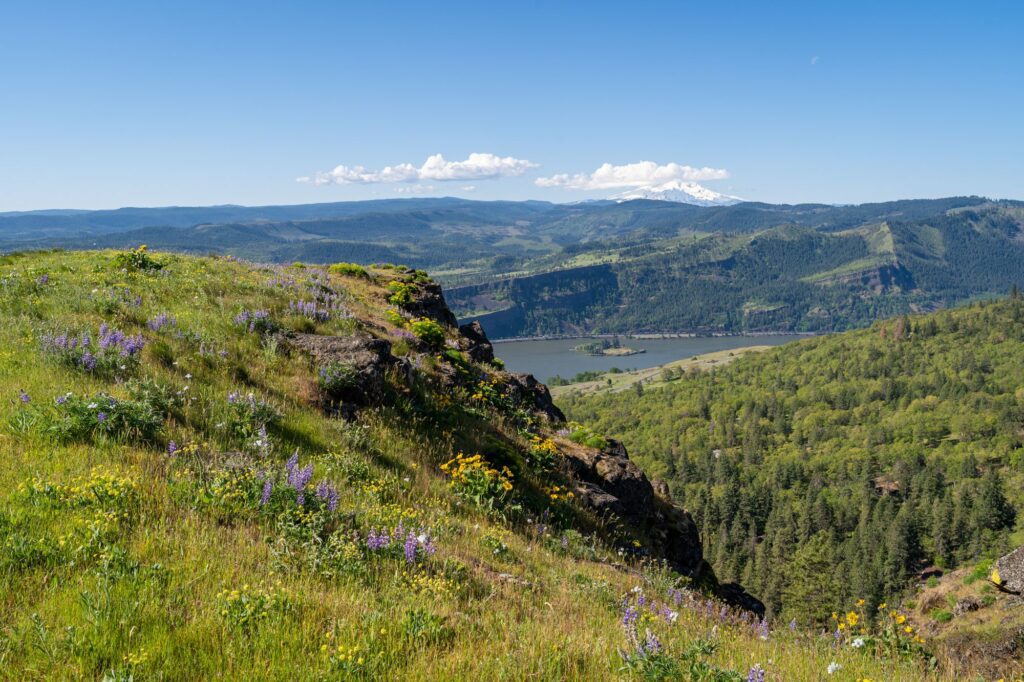
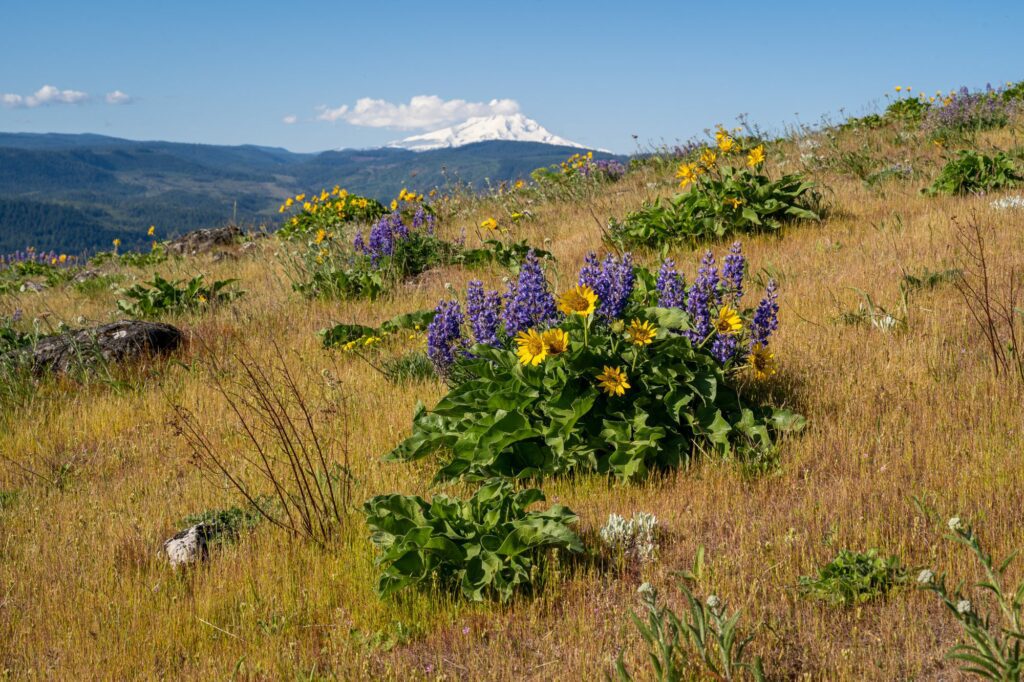
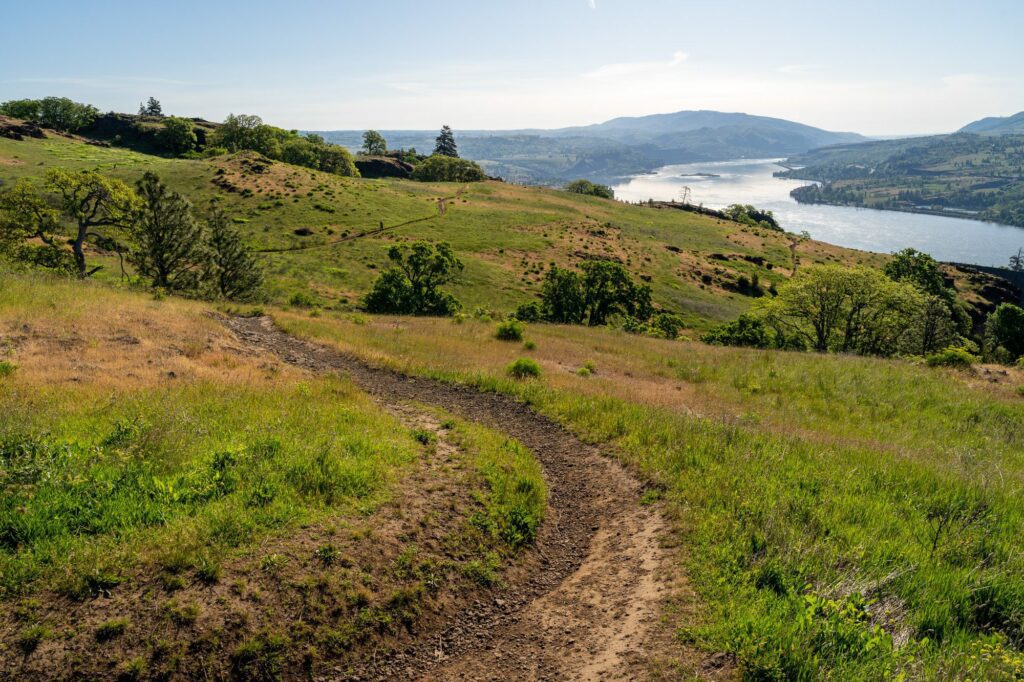
However, while we said “all-season”, we probably wouldn’t recommend this hike in the summer and early fall because it gets HOT out in the Gorge, and there is exactly zero shade on this trail.
This hike is on the Washington side of the Gorge, and leaves from a trailhead about four miles east of the town of Bingen (on the Washington side of the Hood River Bridge).
From there, you have two options – make it a lollipop (which involves a climb along the rim of the wall, which is exposed and probably not ideal for kids and dogs) or do an out-and-back hike along the more meandering eastern half of the lollipop (which is what we like to do with the dog).
Along the way, the views just continuously get better and better until you’re atop the wall with great views of Mount Hood across the river, and in both directions up and down the Gorge.
Get an early start and bring lots of water – it’s exposed, and it can be very hot out there.
Read More: Hiking the Coyote Wall Trail (Our Favorite Hike in the Gorge)
Trail of Ten Falls (Silver Falls State Park)
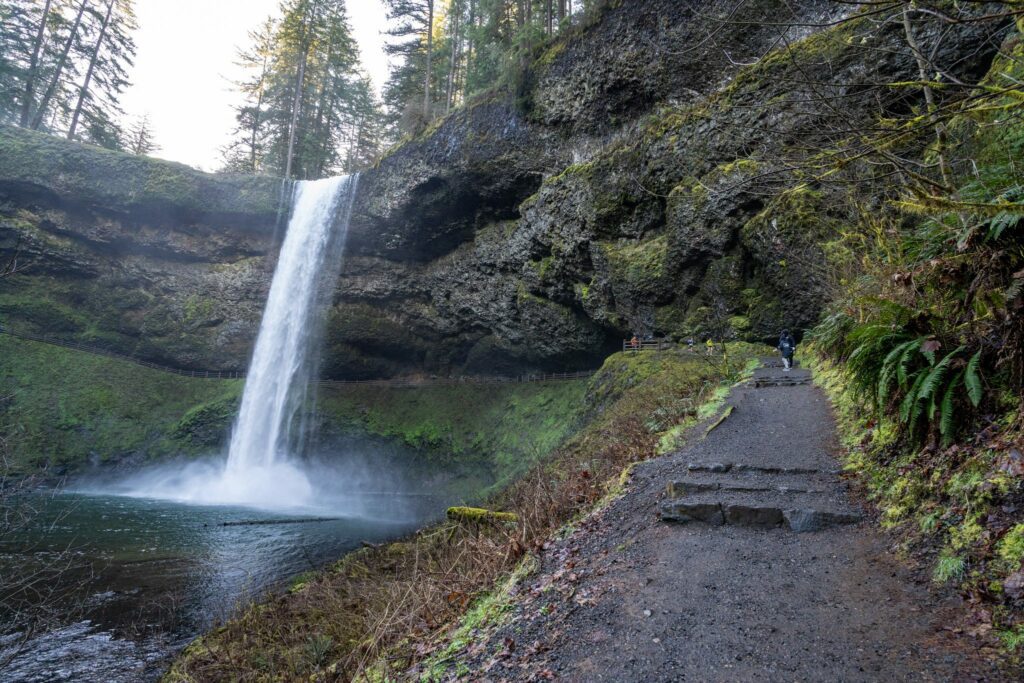
- Length: 7.5 miles
- Elevation Gain: 1,200 ft.
- Trail Type: Loop
- Difficulty: Moderate
- Pass Required? Oregon State Parks Pass
- Dog-Friendly? No dogs allowed
- Trailhead Location: South Falls Lodge Trailhead
- Drive Time / Distance from Portland: 1 hour 20 minutes / 57 miles
The Trail of Ten Falls down in Silver Falls State Park might be the best waterfall hike in Oregon, which is a state FULL of amazing waterfalls.
We’ve done this loop several times now, including a recent trip with Matt’s mom in the early spring to see the falls at their highest flow, which was spectacular.
The name pretty much describes the hike – you’ll do a big loop through Silver Falls State Park, and along the way you’ll see TEN different waterfalls.
It’s magical.
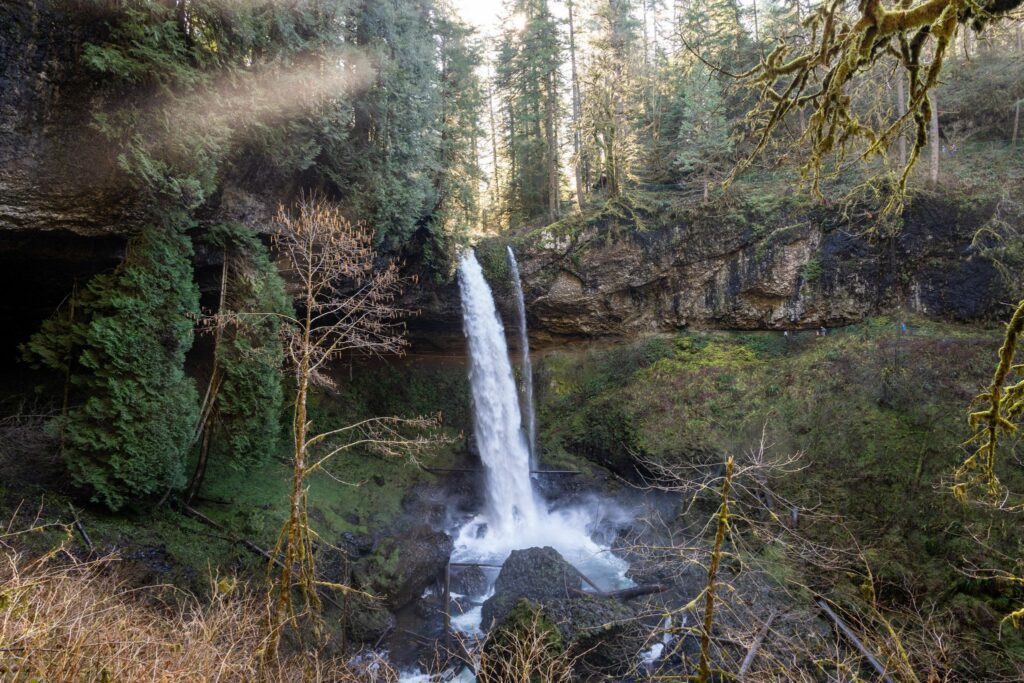
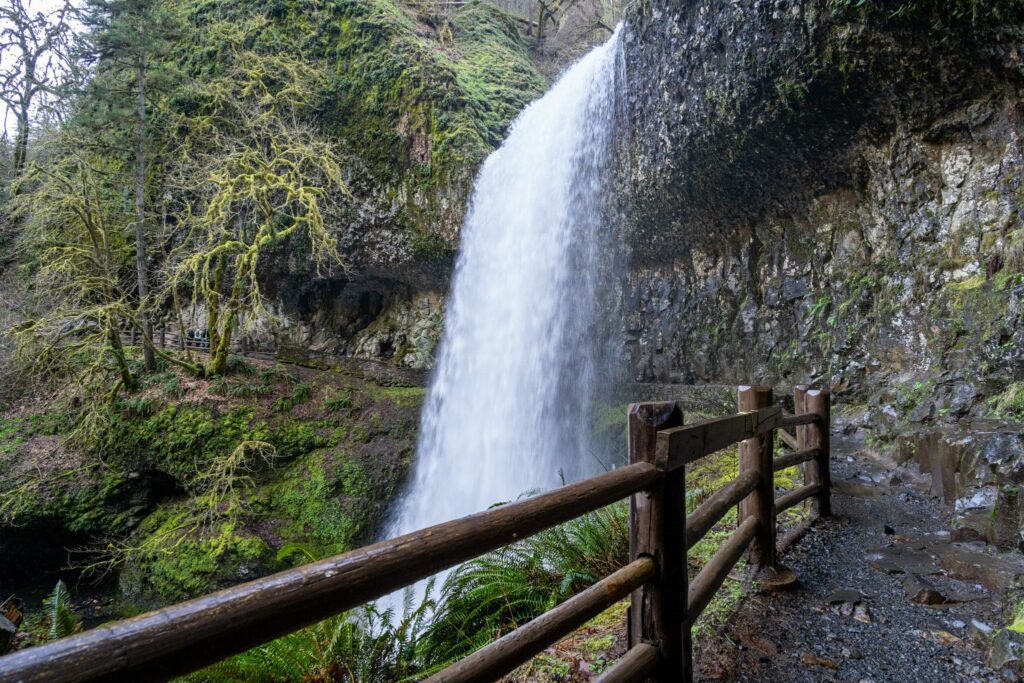
The hike itself isn’t particularly hard, though it is a little bit long to be in the “easy” category.
The loop combines the Canyon Trail and the Rim Trail, and the best part of the loop (where you’ll find all the waterfalls) is the Canyon Trail.
We’d start at the main parking lot near South Falls, a 177 foot waterfall tumbling off of a rocky bowl, and go clockwise, starting with the Canyon Trail and ending with a forested walk back to the car on the Rim Trail.
Don’t miss Upper North Falls on the eastern side of the loop!
P.S. It’s well worth stopping in Salem, the capital of Oregon, on your way home if you have the time.
We love the freshly fried donuts at Bigwig, and Xicha Brewing’s beer and tacos would make excellent recovery food.
For more information, including logistics and a trail report, read our guide to hiking the Trail of Ten Falls.
Memaloose Hills (Columbia River Gorge)
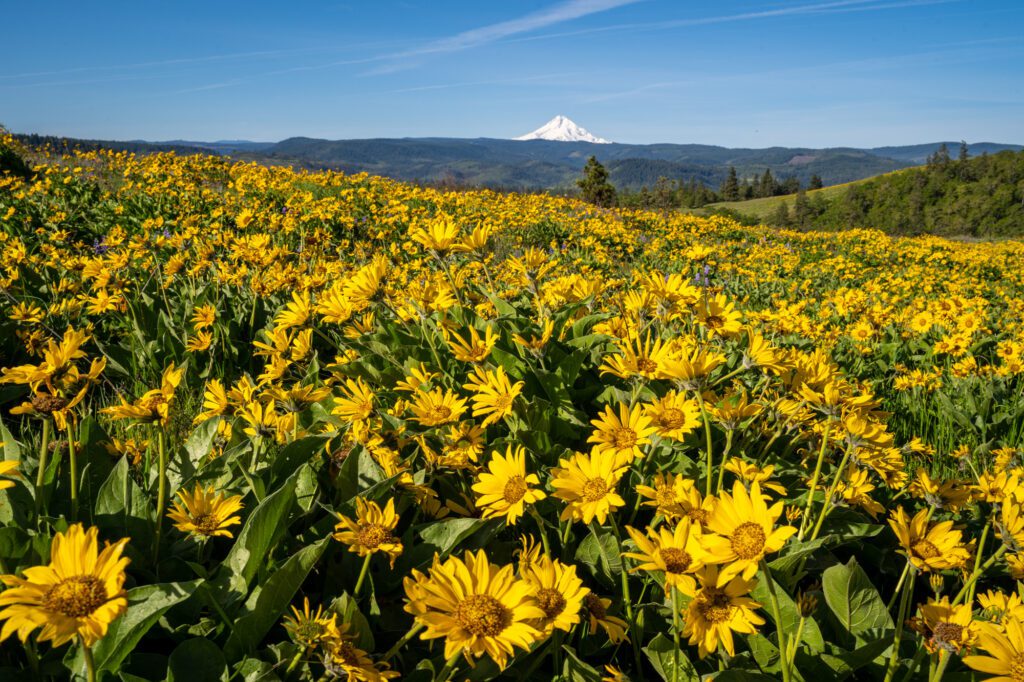
- Length: 2.8 miles
- Elevation Gain: 600 ft.
- Trail Type: Lollipop
- Difficulty: Moderate
- Pass Required? None
- Dog-Friendly? Yes, on a leash
- Trailhead Location: Memaloose Overlook
- Drive Time / Distance from Portland: 1 hour 20 minutes / 71 miles
There are two reasons why this hike is here on this list.
The first is the absolutely incredible display of wildflowers, including balsamroot and lupine, when we were here a couple of springs ago.
The second is the great views towards Mount Hood from the back half of the loop.
It’s in Memaloose State Park, which is east of Hood River further into the Gorge (but before Rowena Crest), and the trail itself is a lollipop that takes you up to the summit of two relatively small hills over the course of the hike.
It was just nonstop wildflowers when we were there in May of 2023, and it’s one of our go-to springtime Gorge hikes because it’s an easy hike, and it’s perhaps the best display of wildflowers on the Oregon side of the Gorge.
McNeil Point (Mount Hood)
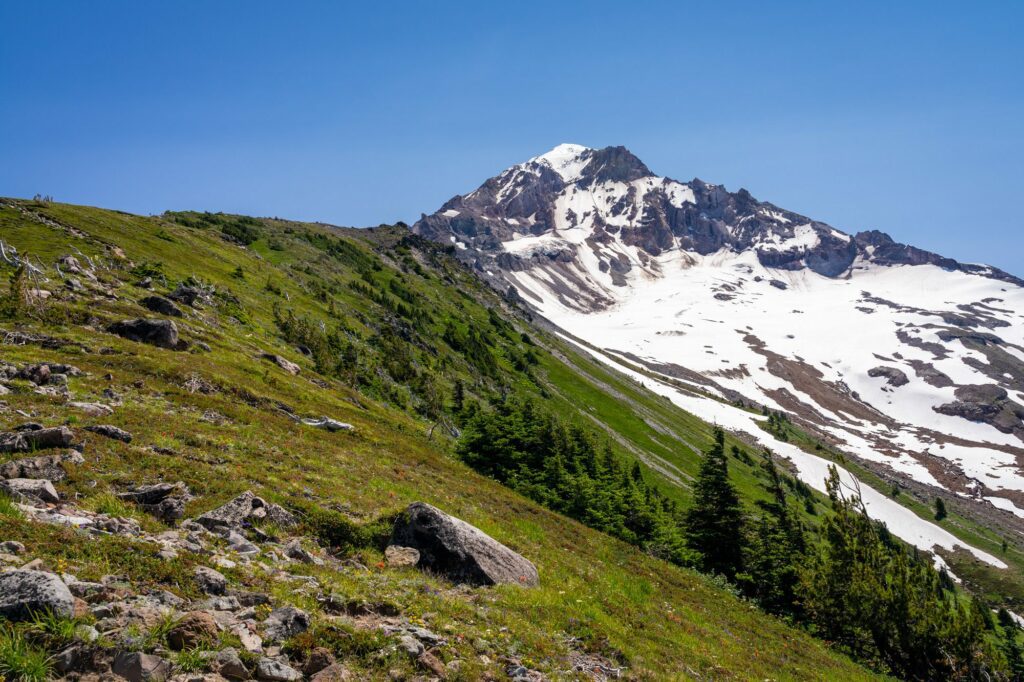
- Length: 11 miles
- Elevation Gain: 2,700 ft.
- Trail Type: Lollipop
- Difficulty: (Very) Hard
- Pass Required? Northwest Forest Pass
- Dog-Friendly? Yes, on a leash
- Trailhead Location: Top Spur Trailhead
- Drive Time / Distance from Portland: 1 hour 30 minutes / 57 miles
I’m fairly certain that this is our favorite hike in the entire state of Oregon.
However, I’m also not certain that we would do it again anytime soon. This hike is TOUGH, y’all, and you need to be prepared for a long, strenuous hike when you set out.
That means proper footwear, lots of snacks, plenty of water, and a map (which can be digital).
The first mile or so of the trail gets you up to the Pacific Crest Trail, which takes you out to Bald Mountain, our favorite view in the state of Oregon.
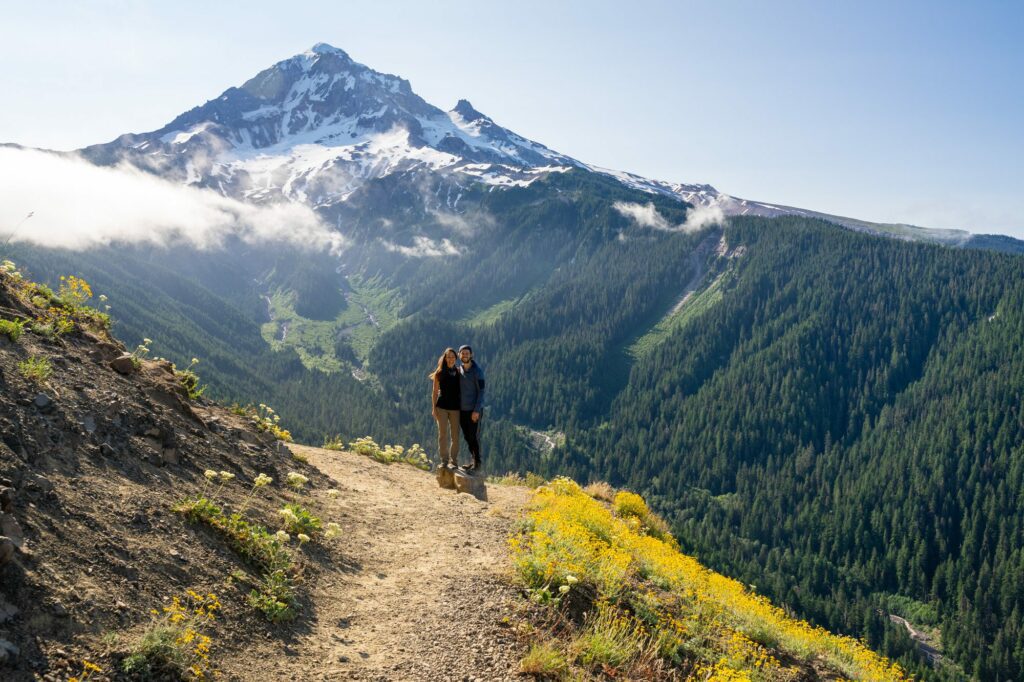
In the summer, the wildflowers and stunning view of Mount Hood here are spectacular. It’s hard to believe that it could get any better than this!
From there, it’s a long uphill hike that is relatively steady in terms of elevation gain. Eventually, you’ll reach the lollipop section of the hike.
THIS IS IMPORTANT: The right side of the lollipop involves what is essentially an all-out scramble that we would definitely not recommend coming down.
For that reason, we’d do the lollipop counter-clockwise, doing the steep scramble on the way up, and coming down the more steady, established trail.
If the scramble section makes you nervous, you can also do this hike as an out and back, following the left side of the lollipop to the top, and coming back down the same way.
It adds a mile and a half to the distance, though.
This is actually what we did, because we got to the top and realized that we weren’t into the idea of a downhill scramble, so we went back the way we came.
Read more in our McNeil Point Trail guide, where we go over your different route options.
At the top, there’s a cool stone shelter, and an up-close-and-personal view of Mount Hood.
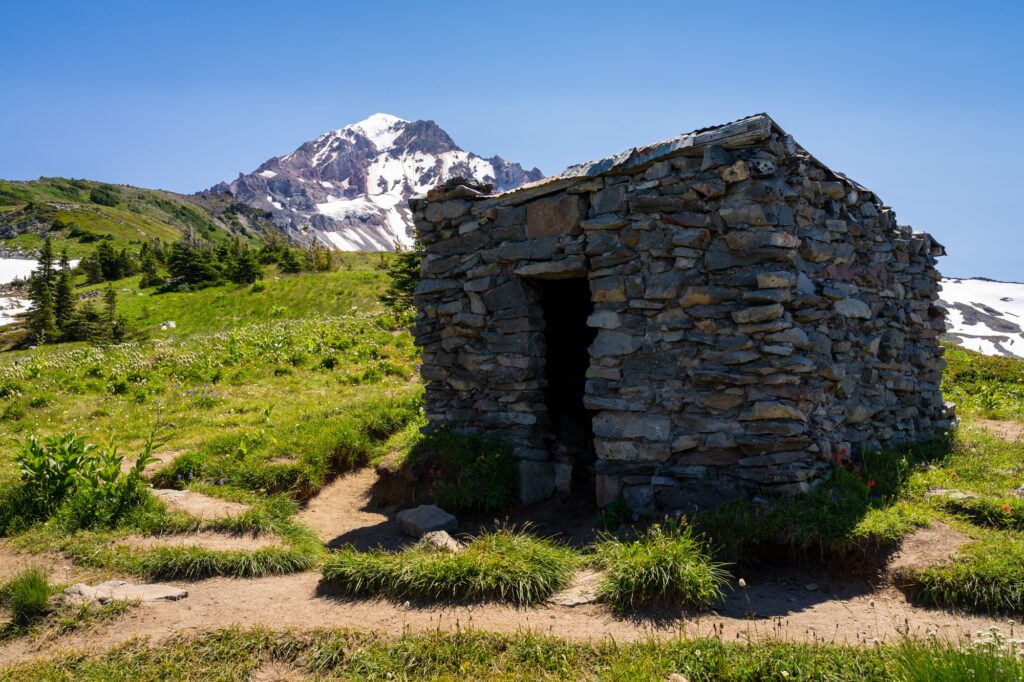
You’ll climb up the ridge, getting closer and closer to the face of Hood as you climb. It’s gorgeous up there, if not a little windy.
Saddle Mountain (Saddle Mountain State Natural Area)
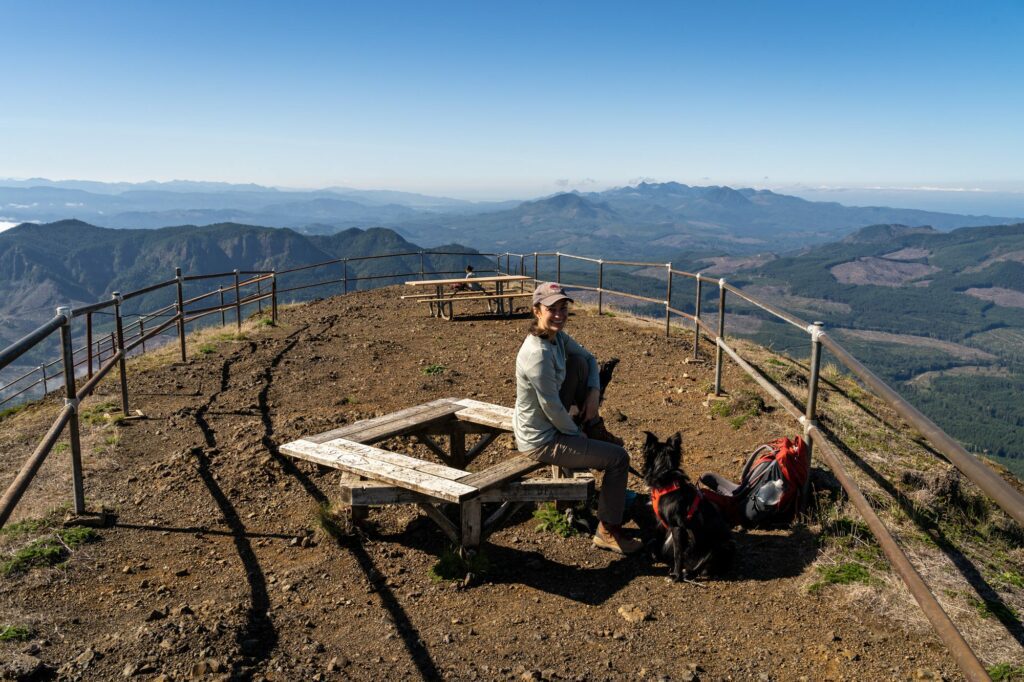
- Length: 4.8 miles
- Elevation Gain: 1,800 ft.
- Trail Type: Out and Back
- Difficulty: Moderate / Difficult
- Pass Required? None (even though it’s in an Oregon State Natural Area)
- Dog-Friendly? Yes, on a leash (see note on mesh along trail below)
- Trailhead Location: Saddle Mountain Trailhead
- Drive Time / Distance from Portland: 1 hour 30 minutes / 72 miles
We got to the trailhead for the hike to Saddle Mountain on a Friday morning at about 8:00am after driving almost exactly 90 minutes from Portland.
It was two days after this trail had opened after two (ish) years of being closed, and we were greeted with what felt like a thick blanket of coastal fog at the trailhead.
Keep in mind, this hike is popular because it takes you up to the highest point in the northwest corner of Oregon, where you have views from the ocean to the Cascades.
“Well, we came all the way out here, might as well head up and see if it clears” we told ourselves as we started up the trail.
Turns out, that was a fantastic decision, because the 1,800 or so feet of climbing took us above the fog line, and we were treated to spectacular views out over northwest Oregon (and southwest Washington State).
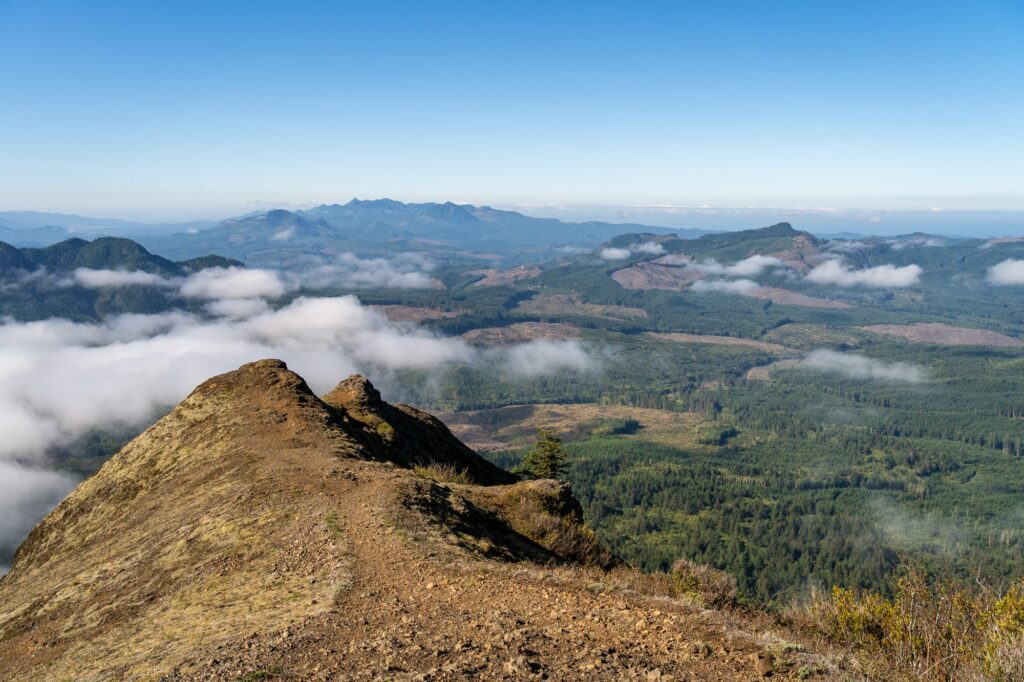
From the viewpoint at the top of Saddle Mountain, we could see clear out to the Pacific Ocean and up to the mouth of the Columbia River, which Lewis and Clark traversed a few hundred years ago.
In the other direction, all of the mountains were out. Mount St. Helens, Mount Adams, and Mount Hood were visible directly to the east, and Mount Rainier could even be glimpsed out to the northeast!
The trailhead for Saddle Mountain is out on Highway 26, about 90 minutes east of Portland just before you get out to the coast.
The thing to know about this hike is that the first half is on the easier side of the moderate category, and the last half of this hike gets progressively harder until the last quarter mile, which we think is firmly in the “difficult” category.
It starts with a winding climb through the forest, and ends with a steep, rocky climb to the summit after the saddle.
On the way back from the hike, we were talking about how this hike would make an excellent start to a day trip out to Cannon Beach, where you could have lunch, shop in Cannon Beach, and hang out at one of the many beaches for the afternoon before heading home.
One note for dog owners: The top half of the trail – from the saddle to the peak, mostly – is covered in what is essentially chain link fence laid down along the trail. We took our dog Lupine up with us not realizing this, and while she didn’t have any injuries, she definitely was not a fan of it, and I can see it being troublesome for dogs, especially bigger ones.
The Best Portland Hikes, Mapped
Here is a handy map so that you can visualize exactly where the hikes we’ve mentioned in the guide above are located.
Things to Know Before You Hit the Trail
Here are a few things to know before you get out and explore.
Dogs are generally allowed (with a few exceptions), but they need to be leashed.
You cannot take dogs on the Trail of Ten Falls at Silver Falls (the lower half of the trail, which is the spectacular part, is dog-free), but they’re allowed on most hikes in the Gorge, on the Coast, at Mount Hood (which is national forest land), and in Oregon State Parks (and Washington State Parks).
Be prepared to be wet. Outside of July, August, and September, you’re fairly likely to encounter either active rain or the remnants of rain, which usually means mud.
We’ve done a couple of these hikes in the winter and spring that top the list of the muddiest trails we’ve ever hiked (especially in the Gorge and the Coast, which seem to be perpetual mud baths due to the inherent moisture).
Bring a rain jacket and some waterproof shoes or boots, you won’t regret it!
You’re going to need a car to get to the hikes near Portland. There’s no getting around it.
Except if you’re planning on doing Multnomah/Wahkeena Falls (which you can use the Sasquatch Shuttle to reach, and even then you need to get out to their parking lot in the Gorge), there aren’t many public transportation options to speak of for the hikes outside of Portland.
Trailheads can be VERY busy, especially on weekend mornings in the summer. Be prepared to get an early start and arrive at the trailhead before 9am in most cases to secure a parking spot (it can be even earlier than that at some of the more popular hikes on this list).
Roads close during the winter months (and many trails at Mount Hood and the Gorge see snow). Many of the roads and to access trails in the areas around Mount Hood and the Gorge are closed during the winter.
In the mountains, this means after the first snowfall, which is typically late October or early November.
Trails at Mount Hood (and some of the higher elevations in the Gorge) are not going to be fully snow-free until late June or early July.
